#in a less popular medium getting adapted into a more popular one
Text
I haven't seen it in a while but I feel like Dororo (2019) is one of the very few cases where a darker reboot actually works because it doesn't feel like it was made to make the series "better" by making it more serious but instead to look at the concept from a different angle and really run with what it would be like to have to regain body parts and senses that you haven't had your entire life. I haven't read the source material so I'm not making a claim that either the original manga and anime are better or worse, and more that the most recent adaptation is a really interesting take on the concept and I feel like with a lot of reboots, especially rn, that doesn't happen too often.
#ive been thinking a lot about adaptations and reboots lately#especially since weve been getting so many of those in tv and games#and the process of adaptation is really interesting in general like switching mediums is a lot of work!#i feel like a lot of people judge the quality of an adaptation based on how accurate it is to the source material#which i definitely get#it can be frustrating when an adaptation of something is completely different especially when it comes to something#in a less popular medium getting adapted into a more popular one#but i genuinely think an adaptation doesnt have to be accurate to be good#i think as long as its evident that the people making it actually gave a shit and engaged with the source material an inaccurate adaptation#can work#and deviation is necessary in adaptations. imagine if the recent last of us show had every single little zombie encounter#anyway#dororo#dororo (2019)
3 notes
·
View notes
Text
Wishing for the Netflix Live Action Avatar series to be bad and jumping to conclusions based on one-off interview comments isn't it. This show is reclaiming its culture inspiration and being led by a majority POC cast and crew, so the hope for its downfall is icky to me.
I've discussed this on Twitter a lot, but not on here. I find it incredibly frustrating that people seem to be wishing for the live action Netflix version of Avatar to fail. This fandom is so dead set on commiserating and hating that they're damning the show before it even comes out and they see a single second of it based on a few lines from interviews taken out of context.
The watering down of sexism from Sokka could be done in just such a way that translates better to a live action format. It makes sense for Sokka to be sexist in a way that believes in rigid gender roles, but still appreciates the roles women perform. In the cartoon, he was more disparaging of women's roles in general. I think this would be a suitable change that still addresses sexism.
The change of Katara's role in regards to sexism I welcome as a breath of fresh air if it's done how I expect. Katara was portrayed as motherly, and I hope that stays, but her motherliness was seen as nagging, annoying, and a bad thing. She can keep these traits, but be appreciated and not depreciated every second and seen as a bore. She is also a child and deserves to be viewed with the same depth and appreciation as the others.
The Game of Thrones comment also makes sense. This is a show primarily for older audiences who grew up watching Avatar. GOT is a popular, beloved fantasy drama series. Many people who watched ATLA as adults compare the appeal of Avatar to GOT. The comment does not mean that the show is going to have sex scenes and SA scenes. It means it's going to appeal to that sort of audience, which makes complete sense for a fantasy live action series. The head runner of the live action show also stressed that the integrity of the show and its characters remaining intact was pivotal to their depiction. So, striking a balance between making this something fresh and interesting in its new medium, but staying faithful to the original should actually be seen as a promising aspect for the series, not something detrimental. I'm so hackneyed by this fandom's obsession with dragging everything down.
Azula having a bow and arrow is badass. Zuko had the dual swords. I have no idea why anyone is mad about this. It's cool. Her coming in early in an 8-episode series makes sense. She's the best villain in the show, she SHOULD get more screentime. It's not like Toph where her Book 2 introduction is concurrent with the pacing of the plot. I also hope Zuko is on the gaang's side for the entirety of Book 3. I always thought that would have made more sense, gave us better friendship building moments, and improved pacing. This criticism confuses me.
And, the thing about Aang not going off on side quests is simply logical. Of course Aang can't be mentioning side quests and frivolous detours like riding on the sea eel (sorry I forget its proper term rn lol) because the way the show is being adapted does not have any time to show these kinds of filler episode scenes. It's being reimagined as a mini series drama with 8 episodes. It makes no sense to subdivide these episodes to include filler moments, so of course Aang needs to be more plot driven becasue there's less breakdown in the episodes because there are less of them. It doesn't negate his childlike eagerness and faithfullness to his original portrayal. It could also serve as an enhancement where this 20-year-old series fell short, despite its successes.
This is a reimagining, otherwise there's no point. A carbon copy would be absurd and terrible for anyone to watch. Wishing a show to fail that was created by an almost entirely POC cast reclaiming the show's culture is so icky to me and I think it's a disservice to this fandom. I'm hoping for the best and being cautiously optimistic. Of course, things could go sour, but why expect it? Why not hype the show up instead of aspire for its failure? Especially in the Zutara fandom, we should be better than this. There is so much opportunity for this series to correct the problems our fandom at large has been complaining about for years and years.
For the bulk of the fandom, including casual and nostalgic fans, they don't know the horrors of the behind the scenes nonsense Bryke, the two white guys who created ATLA caused. So they're crapping on this version left and right because Bryke left. Bryke didn't even create these characters' depth. They didn't write the intricacies of the beloved episodes or develop the characters the way people are so found of. That was the other writers. Bryke wanted Toph to be a boy and have a love triangle with Aang and Katara. They also wanted Azula to be a boy. They wanted Iroh to betray Zuko and be pro-Ozai at the end of the show and Zuko have to choose between Iroh and the fate of the world. The other writers changed this. Look at the mess they made of LoK without the input of the other writers when they were writing entirely on their own in Legend of Korra book one. Their removal is a chance of further improvement.
#netflix live action#atla netflix#avatar netflix#netflix avatar#netflix atla#live action avatar#live action atla#zutara#aang#katara#zuko#sokka
387 notes
·
View notes
Text
Rating the most gayest King David adaptions
For the past few weeks, I have been watching and reviewing ALOT different adaptations of the story of King David from the Bible to determine which ones are the gayest.
But first, let me provide you with a recap of David and Jonathan's story.
David and Jonathan were two central figures in the Hebrew Bible, with their story primarily found in the First Book of Samuel. David was a ruddy shepherd boy who became famous for slaying the giant Goliath with a stone and a sling. Jonathan, on the other hand, was the son of King Saul, the first king of Israel.
Jonathan's heart was captured instantly upon seeing the striking young hero. As the Bible says, “The soul of Jonathan was knit to the soul of David.” Shortly after their first meeting, David and Jonathan expressed their commitment by making a covenant with each other. This significant moment is vividly portrayed in 1 Samuel 18:3-4: "Then Jonathan made a covenant with David because he loved him as his own soul. Jonathan removed the robe he was wearing and presented it to David, along with his armor, sword, bow, and girdle."
David and Jonathan grew so close that it appeared they might one day rule Israel together throughout the following 15 years. However, they faced numerous challenges when King Saul grew jealous of David's popularity and success, fearing that David might take the throne from his family. Saul attempted to kill David multiple times, while Jonathan consistently came to his friend's rescue through various means.
However, they were eventually forced to part ways.
"And as soon as the lad was gone, David arose out of a place toward the South, fell on his face to the ground, and bowed himself three times. They kissed one another and wept, one with another, until David exceeded."
Tragically, Jonathan lost his life in battle against the Philistines, leaving David in deep mourning. He composed a heartfelt lament known as the "Song of the Bow" (or what is famously called “How the Mighty Fallen”) to honor Jonathan and Saul's memory.
"I grieve for you, Jonathan my brother; you were very dear to me. Your love for me was wonderful, more wonderful than that of women."
So, as you can see, I will rate each adaptation based on its portrayal of three specific moments:
Jonathan removes his clothes and makes a covenant with David.
When they have to separate from each other, as they embrace, kiss, cry, and David exceeds.
David's lament that he loved Jonathan more than women.
If these three moments are faithfully retained in the adaptation without altering the text, it will be considered queer in my evaluations. Naturally, there may be exceptions if the adaptation deviates significantly from the original material or if it primarily focuses on adapting specific aspects of the story while still hinting at or incorporating subtexts. In such cases, they may also receive points.
NOW, LET'S BEGIN!
Disclaimer: Some of these "reviews" will sound professional, while others I will act like a gremlin, because these movies actually broke my brain cells. So if you get whiplash from how my behavior suddenly changes all the time, consider yourself warned.
Another disclaimer: Don't be like me and do something similar to this... I don't think this was healthy for my brain.
Jonathan what now..? 1/5
So I'm going to be kind and bring up that the story of King David is long, especially if you make an adaption of his whole life. It's reasonable to expect modifications to accommodate the chosen medium. And frequently, this leads to Jonathan's character being sidelined, either because he's deemed less important or because there's too little time to delve into his role in the story.
Due to that, I won't delve deeply into those adaptions because of that.
Superbook Reimagined (2011) - CBN
Jonathan doesn't exist in Superbook... That all. I WONT TALK ABOUT THE SUPERBOOK.
David and Goliath - Animated Stories from the Bible (1985) - Rich Animation Studios
So this one is pretty interesting. Apparently the same studio that made The Swan Princess (1994) made the series called Animated Stories from the Bible. And I weren't aware of this while watching this episode, however I did noticed, that yes, this had a very low budget but you could tell that it was made by professionals.
I have one thing I need to comment on this movie. Eliab and Jonathan looks pretty goooood...
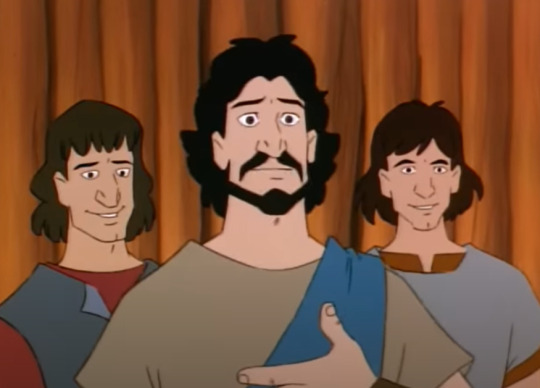

I mean LOOK AT JONATHAN! FFF***KING HELL! HE LOOKS LIKE A HOT VILLIAN AND I LOVE IT!
The character designs are sleek! Expect for David.
David was trash.
So why is this one so low down on my ratings? You see the episode only focus on the upcoming fight between David and Goliath. In a sense, the episode's emotional core are more about David and his brother Eliab, with the brother not believing that David could defeat the enemy. Jonathan has a really small role, and he doesn't really interact with David that much. However there is a scene, when Saul gives his armor to the shepherd and it doesn't fit him cuz he is a smol bean, Jonathan comments on that the boy is going to get killed while having this frustrating / angry tone. Indicating that Jonathan don't believe that David and of course get astonished once he triumph. But that is all we get. I wished I could rate this higher simply to I just love the character designs.
David - A Musical by Sound & Sight Theater
Alright, I'm going to say it. This is probably the most campiest and "we need to tell you about Jesus" - musical there is. The songs are freaking great, very modern, almost anime-ish and very EPIC! But then they suddenly they strike you with, "Hey do you know who Jesus is?"
Anyway, my favorite songs of this musical is Never Back and Psalm 24.
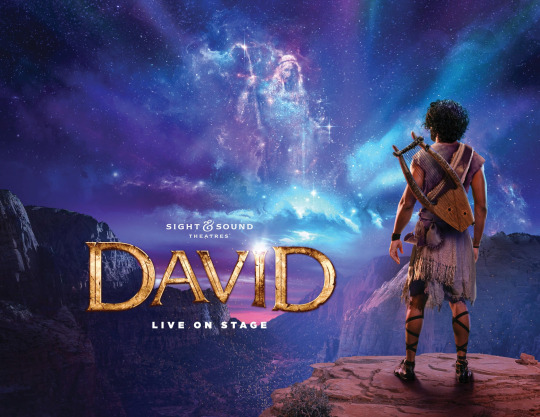
I only listened to this musical on its recorded album. Overall, I found it very enjoyable! However, I was quite disappointed that they didn't have Jonathan none of their songs. There were no solos for him, and all I could do was imagine if there was a strip covenant scene or not between each number. They didn't even have a "We are best bros" song!
They also removed a lot from the emotional core when David mourned the loss of Jonathan. David sings the song "How The Mighty Fall," which is very short, but for some reason, I really liked it. Even though it's short and David only repeats Jonathan's name over and over again, I could feel that sadness. Still, the musical also left out several scenes from the original story, possibly because it aimed to be more family-friendly and was very sanitized so no one would get upset.
AND WHY IS THIS MUSICAL ENDING WITH JESUS?!!
David “the straightest man” and Michal his truest love that has ever existed before Bathsheba came into the picture and a lot of Shoulder Taps for Jonathan 2/5
Superbook (1981) - Tatsunoko Productions
I can't believe that I watched three episodes of Superbook... Can I explain this mess without dying inside? So, this is a Japanese anime from 1981. The series covers the events of the entire Bible in its 52-episode run. I watched the English dub, and yeah, what else can I say? It's probably the best dub I've ever heard, with genius acting, including their screams. You can tell they aren't really screaming because they know it will break the mics.
To get straight to the point, their relationships are just good friendships, and they see each other as brothers. However, they do follow the story very faithfully, pun intended. But, of course, they add in more scenes with Michal so her relationship with David looks romantic, and Jonathan takes on a wingman role.
There is no stripping scene, which is understandable since it's an animated series for kids. Instead, they merge the covenant scene with their separation. To sum it up, they shake hands and repeatedly tell the audience that they are only friends. Okay, we get it!

But then we have the Lament scene:
"Oh Lord, may you have mercy on his soul. Your glory, O Israel, has been slain. How the mighty have fallen in battle. I grieve for you, Jonathan, my brother… My brother…"
THEY WERE SO CLOSE! They looked at the rest, "You were very dear to me. Your love for me was wonderful, more wonderful than that of women," and then they were like CUT!
But the best delivery line in this adaptation must go to Saul:
"How stupid to believe he could murder a hundred philistines without being murdered HA HA HA HA!"
I can't do this anymore…!
King David (1997) - Mondo TV
This Italian animated movie features child actors who can't seem to deliver a line without mumbling and speaking at the lowest decibel levels imaginable. Thank goodness that Kid David and Kid Jonathan grew up after… Let me check… The first 15 minutes of this movie… Well, they are childhood friends in this one, so I guess that's a win.
Michal is from Sweden.
Saul repeatedly tells his (also Swedish) wife to stfu in every scene he's in.
Storywise, this movie shakes things up a bit. When David is chased into the wilderness, both Michal and Jonathan join him…? It's really confusing what's going on because the next moment Jonathan is back with Saul, hearing his plan to attack David in the mountains, so he runs back to David to deliver the news. All of this happens in about 3 minutes. But when they finally have their farewell scene, they, of course, do the Shoulder Tap! However, they hug with an animation that lasts for like 3 frames, and… you know what, I'll just let you witness this…

And then we have the Lament. It's pretty faithful, but as you guessed, they changed the last line from "You were very dear to me. Your love for me was wonderful, more wonderful than that of women." to "I loved Jonathan as a brother. We rode together, his hair flowing free in the wind."
…I don't know if they made it worse or better…
King David - A musical by Alan Menken & Tim Rice
I acted like a fangirl when I realized that Alan Menken and Tim Rice had created a musical about King David! I was so hyped and really thought it was going to be really gay... I think I expected too much...
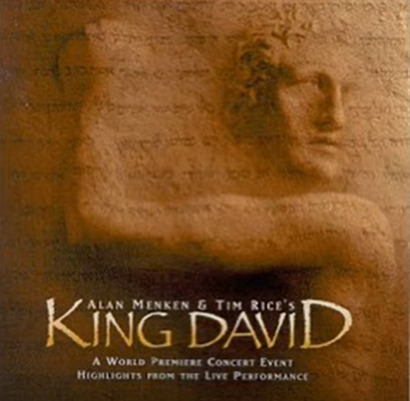
The musical premiered in 1997 and was a grand and ambitious show. While it may not be as well-known as some of Menken and Rice's other collaborations, such as "The Little Mermaid" or "Beauty and the Beast," I was blown away that this musical even existed in the first place.
The music itself is really good. It reminds me of "The Hunchback of Notre Dame" but more campy. My favorite is the song "The Death Of Saul." Genius! And of course, "Never Again," sung by Judy Kuhn. There are so many Disney stars in this show! It's insane!
However, this musical is not without its flaws. The story's scope, which covers many events, can at times feel rushed or disjointed. The mistake that the creators made was trying to cover it all.
So the musical has 2 acts. The first is about David in his younger years until he becomes king, and the second act covers everything from Bathsheba to Absalom's revolt, ending with kid Solomon singing about Jerusalem.
This results in Jonathan becoming like a background character, and this makes me really angry. So almost every scene that David and Jonathan have together, Jonathan is replaced with Michal. TIM?! ALAN?! What are you two doing??? You are basically telling us, without explicitly telling us, that the relationship of David and Jonathan is queer by having Michal instead. Like... what..? This is the same guy who made "Jesus Christ Superstar," and that show is definitely "not straight", so I have no idea what's going on in his head.
Anyway, Jonathan has only 1 song/melody called "You Have It All." It's when Saul shows that he's going crazy when David becomes popular, and Jonathan takes David away from the palace to a safe place. Sigh... You can tell by the lyrics that Tim is trying to be cheeky but immediately backtracks by having both David and Jonathan overly articulate the word "friend" in the song. (I seriously recommend you to listen to the song, just so you understand what I mean.)
DAVID
"I love my friend!!! as I love life and both I cherish. Uncompromising and unfailing. I swear this covenant we make will never perish. In any circumstance prevailing"
JONATHAN
"It's very hard when things come easy. You start to fear a bitter end. I promise you, you have a friend!!!"
However, Jonathan gets a reprise again in the separation scene, but then Michal suddenly pushed Jonathan aside and takes it over with her own song.
Then we have the Lament. The song itself is really good and beautiful. It's like a sad Disney song. But the lyrics themselves have this uncertain tone on who David is singing about. But they do reveal it at the end.
"Jonathan... Jonathan... Who loved me more bravely than you, whether harlots or wives!"
We can clearly see that David mourns over him. But for me, it feels so awkward...
They are just friends..? 3/5
The King: Story of David (2004)
I felt like I was on shrooms watching this. There's this three-minute scene where David sings to Saul... I can't even explain it, it's just horrible. Poor Saul looks absolutely horrified when this abomination of character design from a different show enters the room and sings with the voice of an adult woman.


AND WHY IS MICHAL PURPLE?!
They also switch her name’s pronunciations like 5 times in this movie...
Well, about Jonathan. So they took the approach that David is a literary child and had Jonathan as an adult… What the hell am I supposed to say about this? Oh god... I hate this.

Then David grows up, gets the same artstyle as the other adults and instead of Saul nagging David to marry Michal, it's David himself that asks Saul to marry his daughter, just to make sure that we know that he loves her soooo much. This results in Saul wanting to kill him, which leads to the separation scene.
So maybe you are now asking me, why is this movie up here on the list? Looks like they made sure that David was the straightest man that has ever straightening. Oooh, I’ll get there.
So we get to see a jpg of David and Jonathan look at each other for like 10 seconds, then tap each other on their shoulders, look at each other eyes and David says with the most sultry voice ever “Jonathan…”. Surprisingly, hug each other and weep. huh… didn't expect that.
That voice that David used was enough to make the whole freaking movie a gay so that's why it's up here. If I ever have to watch this again, I need to get paid.
The Bible (2013)
Ah, yes, I remember this one. I watched it when it aired on TV, and I was just a wee little teen falling in love with the guy who played Samson. But we'll be watching the fourth episode of "The Bible Series." This episode was a speed run through the whole story of David, with a lot of stuff cut. Yet, the subtext in this adaptation is gorgeous! We have David walking to Goliath and Jonathan looking on with worry in his eyes—MULTIPLE TIMES! And miraculously, the actor managed to hit Goliath despite having the freaking sun in his eyes at full blast. That poor actor with his nonstop squinted eyes couldn’t see shit on set. Once Goliath is defeated, Jonathan and Saul run to David and are proud of him. All we get from the Covenant Stripping scene is Jonathan taking David's hand and telling him to come with him and fight the enemies, like best bros!
Then a montage arrives, and David and Jonathan are older. Saul is jealous and touches David a little too much for my comfort. Meanwhile, Jonathan is just sitting on the floor eating figs. Wat?
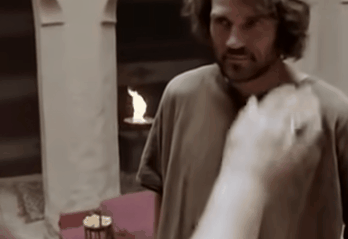
And then Saul proposes the idea that David should marry Michal, and Jonathan's face falls. Gasp!
David gets sent to kill 100 Philistines, and we get this wonderful scene with Saul and Jonathan.
Saul: "You love him like a brother, don't you?"
Jonathan responds with a warm, soft smile, looking at David riding away.
"I do..."
Saul gives off big "My son is totally straight" vibes.
Sadly, this episode neither has the separating scene nor anything that resembles a covenant. And yes, they also skipped the majority of the Lament.
Maybe I am projecting... I am probably projecting.
They are friends! I PROMISE! 4/5
King David (1985) - Paramount Pictures
This movie provides a different angle on the biblical story of David and Jonathan. The film includes a line that suggests a strong emotional connection between the two characters, though it doesn't explicitly delve into romance. It doesn't say that David and Jonathan are in a romantic relationship, but it makes you think that they have deeper layers to their "bond." In other words, I really ship them in this adaptation!
They didn't have the strip scene, but they did have a scene where both of them are at a lake, water sparkling in the sun, looking into each other's eyes. Jonathan softly cups David's cheek and says, "I love you as I love my own soul."
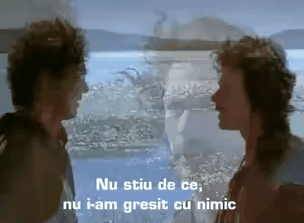

...
Wait, he touched his shoulder softly, not his cheek... Forget it.
But they are very tender toward each other. However, we can't have great things because the separation scene was very weak. All we get is that they are both on horses, and then they just say goodbye, and that's it. No hugs, no tears, no kissing, and no exceeding David.
But I can add that Jonathan's death was very heartbreaking. After watching awful animated death scenes, it was a breath of fresh air. The Lament, for some reason, had a spooky tune, not really like a man grieving for his soulmate.
Why is this adaptation so high up for me? Well, Jonathan said "I love you" while looking into David's eyes with a beautiful natural background. That is enough for me.
Ancient Lovers 5/5
Beloved King: A queer bible musical

(There mentions of SA)
You can already tell by the name of the musical...
"Beloved King" follows the young shepherd David as he is thrust from rural fields into the royal court. After his sudden rise to prominence, David finds himself the object of affection of both the heir to the throne, Prince Jonathan, and his father, the domineering King Saul, forcing David to re-navigate his relationship to love and power as he tries to follow the path laid out for him by a mysterious entity called God.
The first-ever staged readings of "Beloved King," complete with all songs and live accompaniment, were scheduled for March 12th and March 13th, 2020, at Oberon, the second stage of the American Repertory Theater, in Harvard Square. Both events sold out well in advance, but they were canceled the day before opening due to COVID-19. However, the team rallied and quickly pivoted to film a dress rehearsal in an empty theater just before lockdown.
One of the most hilarious things about this musical is that the characters are dressed in simple linen garments that look like they belong in a children's nativity school play, only to have David and/or Jonathan strip and expose their flashy sparkling spandex briefs. Undeniably, it fits perfectly with the nightclub-inspired atmosphere that this show has.
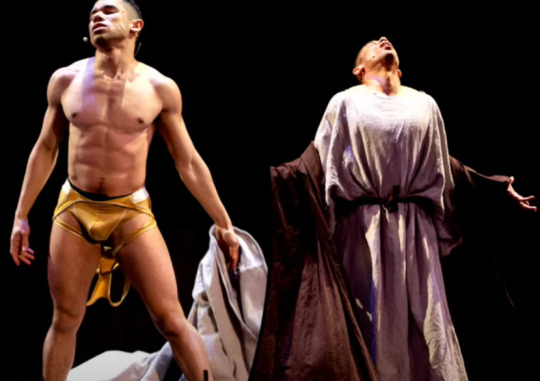
This musical feels like it's straight from the Archive of Our Own. Jonathan and David are dating, and we have a jealous Saul who is not jealous of David's popularity, instead, he desires him sexually and tries to bang him. When David denies Saul, that's when Saul tries to kill him instead.
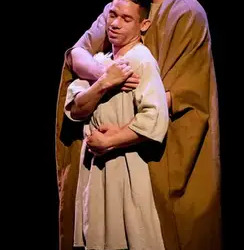

The musical has all three scenes checked. The covenant scene, with Jonathan stripping and "more." There was a scene of their farewell, however, they haven't released that one song, so I can't really say anything about it yet. Lastly, the lament song in its full glory. Sadly, the whole musical isn't out yet. They have only released six demo samples, and let me say that "ADONI" is THE MEET-CUTE SONG!

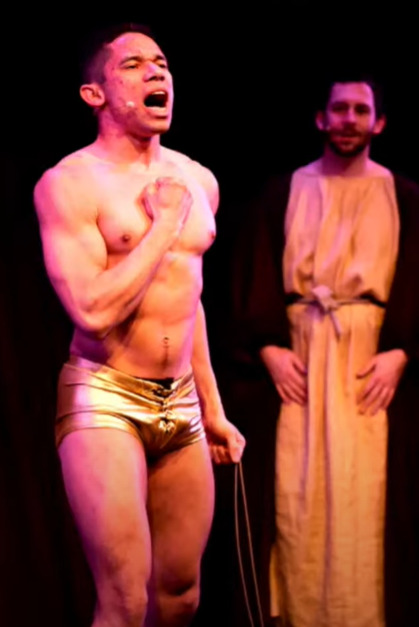
This musical was the very thing that made me nerd out on the Bible again. So maybe I am biased, but how can I be biased if they depict David and Jonathan's first meeting with them banging each other in Jonathan's tent?
David et Jonathas: An opera by Marc-Antoine Charpentier
This one was a hidden gem I didn't know existed. Thank you @alatabouleau for the recommendation! It's an opera from 1688. It's all in French, so I was worried that I would have missed all of the lyrics, but I found a translation pamphlet and found one of the concerts on the live-opera Versailles website. All I can say is it was beautiful and so, so, so queer.

The prologue starts with Saul, disguised as a visitor, consulting the Witch of Endor to learn his fate in an upcoming battle against the Philistines. The Witch summons the spirit of Samuel, who predicts Saul's downfall, including losing his family and crown.
In Act 1, David, banished by Saul, seeks refuge among the Philistines. He returns from a victory and is praised by warriors, shepherds, and freed captives. David only wishes that, whatever may come, Jonathan should be spared. The Philistine king tells David that a truce has been arranged between the Philistines and Saul to discuss whether there shall be peace or war.
In Act 2, during the truce, David and Jonathan reunite. And then they both sing the song “A vostre bras vainqueur,” and it's the most beautiful harmonic song I have ever heard. It sounds so romantic, even if they are only singing about them being best friends. However, jealousy brews as Joabel challenges David to combat, leading to a plot against him. Joabel convinces Saul that David is a threat, leading to David's exile again.

In Act 3, Saul accuses David of treason, and David is forced to leave. However, Jonathan follows David into the wilderness so they can sing their goodbye, “Vous me fuiez!” Don’t forget this is an opera, so everyone is really dramatic, and I'm loving it.
JONATHAN
“You flee from me!”
DAVID
“You always follow me!”
JONATHAN
“May I not share my grief with you?”
DAVID
“See into what danger my misfortune leads you. Let us forget one another.”
JONATHAN
“Cruel one!“
The song continues with them singing about not wanting to be apart and if they see each other in the battlefield, they won’t fight, but instead save the one they love. And then the song ends with David trying to leave again, and Jonathan begs once more, only to be told by David:
“Would you now wish to add to my torment with your tears?”
This song… I want to make an animatic of it...
In Act 4, Saul prepares to battle the Philistines and David. Both armies are eager for war, fueled by Joabel's manipulations. David promises to save Jonathan and his father.
And lastly, in Act 5, the battle unfolds, with Saul's defeat. Then the song “Qu’on sauve Jonathas” starts. Jonathan is mortally wounded, and David finds him. He believes that Jonathan is dead and mourns for him, which wakes Jonathan up to be able to speak to David one last time, asking:
“What sad voice is calling me?”.
David begs Jonathan for him to live, but the prince tells him that he can’t. And with his final words, he kisses David and then dies in his arms.

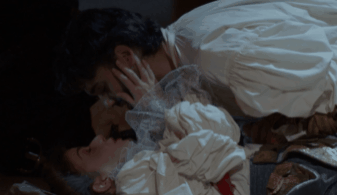
“Despite the harshness of my fate, At least I can still tell you that I love you. ”
David is to be declared the new king of Israel, but he still grieves for Jonathan, ending the opera with his final line:
“I have lost what I love. My Lord, to me all is lost.”
Well, I cried in my bed.
I didn't know that I needed a story where David was by Jonathan's side in his last moments in life. And the kiss! THE KISS! Though the kiss depends on which adaptations you see. If it's 2022, then there is no kiss, but if it's the 2012 version, then there is one. However, with or without a kiss, it's still romantically tragic.
Here is PDF links to pamphlets with english translations:
English translation (2009 version)
English + German translation (1998 version)
The Prince's Psalm: A novel by Eric Swan Quinn
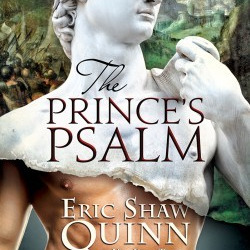
So here it is, Beloved King: A queer bible musical was the one that pushed me down into the rabbit hole but The Prince's Psalm was the one that got me stuck here. I highly recommend this book, and it leaves me speechless how it isn't more popular!
So The Prince’s Psalm is a queer and romantic retelling of the story of David and Jonathan from the Bible.
The book begins with David's childhood, providing perspectives on his early life and relationships, especially with Micah and David’s family. Micah and David had a deep friendship that grew into young love and they became each other's firsts.
A core theme that comes up regularly in this novel is about being treated and viewed as equal in a healthy relationship.
Micah held a weird place in my heart. I enjoyed “not liking” him. I could immediately see his immaturity in his relationship with David. Of course, I understand they were both young and immature, yet this was important to emphasize the message, which I believe it’s about being equal in a relationship. Micah loved David, but he saw him somewhat beneath him due to David not fitting the stereotypical masculine man image. And every time they "play" with each other Micah calls David "My Slave" despite David's irritated and uncomfortable of it.
So the moment when Jonathan is introduced, the first thing he calls David is "My Prince" and do everything that David wishes Micah would do for him but wouldn't. If we are going to compare Jonathan and Micah, it's pretty obvious which one are the right choice.
But who cares about Micah, we are talking about Jonathan and David now!
So the plot follows Jonathan summons David, hoping on his musical talents to aid King Saul's from being tormented by “evil spirits”. David's initial experiences within the palace only reinforce his sense of inadequacy in the eyes of those he admires and cares for. He plays tirelessly, day and night, in an effort to soothe the king's troubles, ultimately healing King Saul's fears of God’s abandonment. From that moment forward, Jonathan can no longer resist David's charms, leading the two to become inseparable. As they spend a winter together, their bond deepens, uniting their bodies and souls. The novel doesn't delve into explicit sexual scenes, instead, it focuses on the emotional connection between the two characters. Nevertheless, they do have quite a lot of intense passionate sessions, it just written with a flowery language.
So their oath, the exchanged rings, the beautiful yet sad promises, is heart moving. Every moment felt perfect and captivating!
Jonathan's death left me shattered. I cried a lot. And cried even more when the book included the whole Lament.
After devouring all 480 pages, I found myself wanting the story to continue. Eric Shaw Quinn made a wonderful job in reimagining the familiar narrative yet adding new in depth layers to it. I wholeheartedly love this novel!
So is it gay?
Yes.
THE END!
Finally, I have finished everything. There was more, but there is no way in hell I will continue.
What did I learn from this experience?
Nothing really, except that the people whose arguments claim that David and Jonathan's relationship isn't romantic at all, yet in the same breath, they can replace Jonathan with Michal, and suddenly it is romantic. I learned that their arguments are worthless at the core.
But despite with the pain and cringing, I loved nerd out about my favorite David and Jonathan adaptations! And I think I did this just because of that.
#I probably will come back and edit this later#mentions of sa#this is a long post#david and jonathan#beloved king: a queer bible musical#animation#the prince's psalm#gay#jonathan#king david#movies#musicals#book review#film review#Sound & Sight Theater#Animated cartoons from the 90s#Alan Menken#Tim Rice#Reviews#i am going insane#bible is gay i promise#bible fandom#Dont do this Its not worth it#queer media#not so queer media#opera#Ancient Queer History#AnniRambles#David/Jonathan#Bible Adaption Reviews
87 notes
·
View notes
Text
How to remake Harry Potter:
(A step by step guide)
We’ve already had one god-awful adaptation that way too many people think is good. This is our one chance to have the book characters represented correctly, along with the plot they support.
I’ve put YEARS of thought into this. I’ve written scripts for episodes of a hypothetical tv show. I’ve drawn concept art. I’ve done shit. So I figured I’d share my thoughts.
1. Stick to the books*.
Stick to the books has a massive asterisk next to it because I mean the plot and characters. Some stuff (as you’ll see later) should be changed.
Nothing in this show should feel out of character. Harry should be closer with Ron than he is to Hermione. Snape should be a real d*ckhead. Hermione should be judgmental of those who don’t think like her, etc etc. The way these characters navigate their relationships is why the fandom is still relevant. It’s why canon-compliant fic is popular in the first place. We like their dynamics. SHOW THEM APPROPRIATELY.
Plot is a sticky thing because I’d say there’s wiggle room, but not too much. Certain characters have to die. Certain events must happen. You cant change that stuff.
2. Use the Medium.
You’re using film as a format to tell your story. Ideally you’d us animation, but I know Warner Bros has less creativity than Disney’s remake department, so I won’t even try and pitch that.
Use colour and saturation. It can help contextualize emotion. It can make us subconsciously recognize things. For instance, the scene growing more saturated when Ron walks into the room when Hermione is wearing the horcrux, or any multitude of other uses this could bring.
Bring in costume design that (actually fits the world) but also helps show how that character is feeling. What they’re thinking, their personality, their future, etc.
Make magic fun™️. The books sort of sidelined magic in 5-7. Don’t do that. Divert from the books. Magic should feel alive. Colour-code them so we as an audience can recognize spells and what they might do before we see it. Implement sound design to make each spell unique and vibrant. Make this world subtly bursting with magic like it was in the first few books. Have it weave around characters, wrap them up. Be creative with action scenes. Force transfiguration into battle scenes. Choreograph your duels. Show don’t tell us that a wizard/witch is powerful. Turn people into portraits. Lock them up as mice. USE MAGIC.
Your set design should reflect this. Everything should be bursting with personality. Don’t just use the shitty movie sets. Inject some colour, have the surroundings aid you in telling the story. Get weird with the camera. Use these tools to their fullest potential.
Actually fucking try.
3. Utilize Music.
Music is just… such a massive part of film. It’s frustrating how often even the best filmmakers overlook its use. Characters should have themes that mature and develop as the series goes on. Have action arrangements of the themes to play with heroic moments. As the series progresses, we grow attached to these themes. When they appear, the audience FEELS something. Don’t reuse great pieces to force emotion. (Dumbledore’s Farewell in The Prince’s Tale. Are you fucking kidding me?)
For example: Have a theme for Neville that starts out timid and uses very shy instrumentals, but we first hear a change when he stands up to the trio at the end of PS. Then it gains more instruments until OotP, when it grows again. Once we get to DH, it can be used in this heroic swell as he chops the head off the snake in front of Voldemort and everyone watching. The audience, consciously or not, will feel that moment even more.
Have a theme for Ron and Hermione that might not even be romantic until HBP when it gains that element. PLAY WITH MUSIC.
Themes for mystery, adventure, loss, love, friendship, LOCATION. Let them come back throughout the series to highlight various moments. See Lord of the Rings and The Hunger Games, as well as (surprisingly) the Fantastic Beasts films.
Let music affect the visuals. Magic can bend and swivel with the music. Use it to tell the story. Use it to show emotion. Use it to progress a character’s arc. USE CONSISTENT MUSIC.
4 . Be Bold.
This is the big one and it may seem like I’m contradicting myself but I’m not. Rowling’s work hasn’t aged crazily well to modern fiction standards. This is your chance to rectify that. Fill plot holes, actually think through the politics. Introduce world-building elements that enhance the story/characters. (The house system, and how Slytherin fits in. The logic behind avada kedavra???) Get creative with solutions. Contradict the original work when it comes to description of location. If it doesn’t work for the film format, don’t force it to work here.
Spend more time with characters we know are relevant, but maybe not to the plot. These are your Ginny Weasleys, your Seamus and Deans, Nevilles, etc. Really fill them in. Give them more scenes. Ginny has two phenomenal arcs that play completely off-screen, explore them. Show us her friendship with Hermione. Show us her insecurities and her faults. Give us more of her and Harry’s friendship. We know they get married, so maybe fix the whole “Rowling wrote the epilogue first, but didn’t realize she was waiting too long to introduce these characters until HBP”.
Add scenes. Add jokes. Add smiles and covert looks. You have more time, which means you have a chance to focus on friendships, and romance, and world building.
Tell multiple storylines. Give Remus and Tonks a cool spy/thriller subplot interjected with the main story in OotP. Show us more of Fleur staying in England. Give us more of Harry and Sirius bonding. All of this stuff can fit loosely into canon, and be welcome creative additions.
BE BOLD.
And finally,
5. This is your chance to not only retell the story, but to do it better.
RECOGNIZE THIS. Take advantage of this opportunity and enhance canon, don’t fight it.
Don’t add Hermione and Harry dancing because *YOU* don’t like where the romantic pairings went. Don’t add Draco sympathy because you want him to have a redemption arc. Don’t dumb Ron down because you don’t like the fact that he’s just like the teenage boys you dated in High School, and he was a bit immature.
Make changes, be bold, use music, stick to the books*, use the medium, but take this as the opportunity that it is to enhance what came before.
Thank you.
#harry potter#harry potter remake#j.k. rowling#ginny weasley#ron weasley#hermione granger#draco malfoy#neville longbottom#albus dumbledore#hire me#remus lupin#Sirius black#remadora#romione#hinny#marauders
348 notes
·
View notes
Text
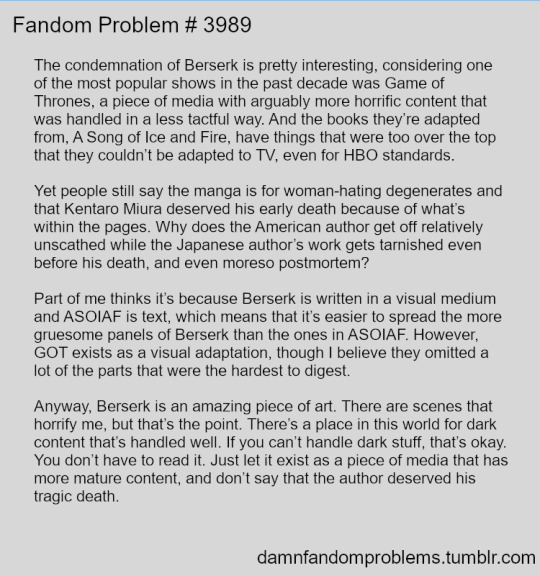
Fandom Problem # 3989
The condemnation of Berserk is pretty interesting, considering one of the most popular shows in the past decade was Game of Thrones, a piece of media with arguably more horrific content that was handled in a less tactful way. And the books they’re adapted from, A Song of Ice and Fire, have things that were too over the top that they couldn’t be adapted to TV, even for HBO standards.
Yet people still say the manga is for woman-hating degenerates and that Kentaro Miura deserved his early death because of what’s within the pages. Why does the American author get off relatively unscathed while the Japanese author’s work gets tarnished even before his death, and even moreso postmortem?
Part of me thinks it’s because Berserk is written in a visual medium and ASOIAF is text, which means that it’s easier to spread the more gruesome panels of Berserk than the ones in ASOIAF. However, GOT exists as a visual adaptation, though I believe they omitted a lot of the parts that were the hardest to digest.
Anyway, Berserk is an amazing piece of art. There are scenes that horrify me, but that’s the point. There’s a place in this world for dark content that’s handled well. If you can’t handle dark stuff, that’s okay. You don’t have to read it. Just let it exist as a piece of media that has more mature content, and don’t say that the author deserved his tragic death.
96 notes
·
View notes
Text
Nayshall's clothing (pt. 1)
I'm gonna be 100% honest with ya'll. I was writing a Bosch smut and for the life of me, I didn't know the names of the clothes he was wearing. But I didn't want to put "Robes" and move on, so I did a deep dive into Nayshall's clothes.
Nayshall is a blend of multiple cultures in one, but the general consensus of forums on Reddit and other forums was that Nayshall was inspired by Bhutan, Nepal, Indian, and Tibet cultures.
This is going to be split into multiple of parts because Nayshall has a lot of different types of clothes so I won't be able to cover it in one sitting. I barely even scratched the surface here.
If anyone is more knowledgeable than me and sees that I got something wrong please tell me in the comments. But I'm posting this because I want people to see the hard work the street-fighting devs put into this and the world of Nayshall.
Chuba


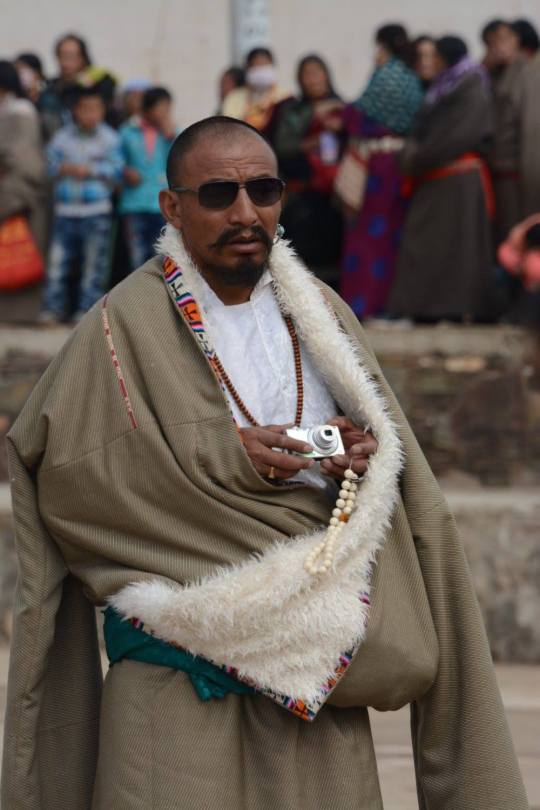
The chuba is a floor-length, left-crossing loose garment that is adjusted at the waist with a wide, usually red cloth belt, and pulled up to different degrees according to sex, rank or region. It is an extraordinarily adaptable garment worn by town dwellers, farmers, nomads, men and women alike, and is equally wearable on horse or motorcycle.
Chubas are pocket-less and held together with a waistband, with room in the front that serves as an “inside pocket” or inner pouch to store necessities such as food items, money belts, amulets, personal things, and even an infant in the bosom.
The chuba can be worn in different lengths, and the shorter the chuba, the more voluminous the pouch resulting from the overhanging material used to hold small items. Women wear their chuba ankle length, while men mostly pull them up the mid-calf or above the knee. Tibetan weather is fickle and temperatures can rise and fall within minutes.
Half-chupas: Just the skirt
Full chupas: Can be worn with a shirt
One-piece chupas: A one-piece dress
Town women: Wear their chubas floor length with pumps or high heel boots
Farmers and nomads: Double them over trousers
Ex: Rewancha, Yua, and Bosch all wore a form of chuba as their gown. The Chuba had 2 sleeves, but the locals usually only wear one sleeve and leave the other hanging loose. This is a way of adjusting the body temperature. When it gets hot, they take off one sleeve to cool down a bit. But if the temperature keeps rising they remove another sleeve too. We can actually see in Bosch's picture that the other sleeve is tucked in the back.
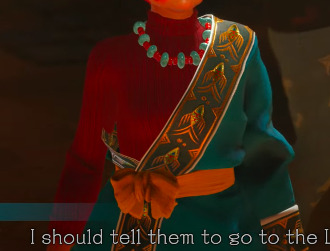


They often have soft fur, pulu, or colorful cloth on the collar, front, cuff, and lower hem of the gown.
5 types of robes could be made out of, Pulu woven fabrics, lambskin robes, sheepskin robes, woolen robes, and light robes.
Woolen robes are made with inner layers of sheep fur, so they are light and warm, making them popular in warmer, agricultural areas like Nayshall.
Pulu, the traditional Tibetan wool fabric, is made by fluffing and combing the wool into a thread by fingers, then weaving it with a wooden shuttle loom. Pulu robes are a favorite in pastoral areas as well as farmland.
Lambskin is ranked by degree, according to the length of lamb hair, curliness, and quality of the skin. 40+ lambskin is necessary to make a medium-class lambskin robe.
Shirts


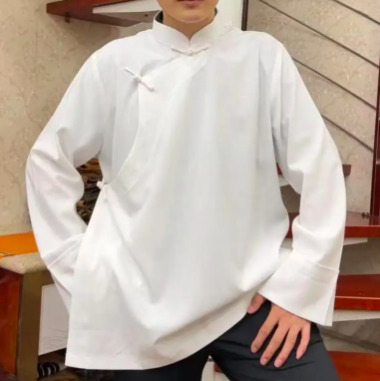
pants

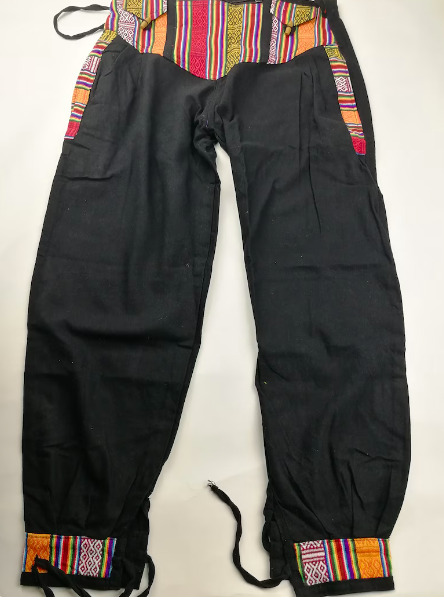

Modern and traditional
A growing trend among young Tibetans is blending traditional and modern casual clothing. Young Tibetans often try to find a balance between modern styles and their cultural heritage. It is not uncommon to see some Western-style clothing like jeans and t-shirts
The classic chuba robe is still everywhere, but Tibetan youth will make stylish adaptations. The cut of the fabric or the embroidered designs will be changed to something more contemporary. These changes show the desire to keep old traditions alive while making innovations to express personal style.
Ex. Same with the people in Nayshall they blend traditional and modern together. Shopkeeper Tsanpa wears jeans with his gho (Bhutan) tucked in. Yua wears modern shoes that resemble Tibetan boots, and Kina wears a beanie on top of her head.



note that Kina may also be wearing a Kora Yushu hat.
The Kora Yushu hat is made from a blend of yak and merino wool, and its fabric originates from Tibet and China. Kora sources the wool directly from Tibetan communities to ensure its quality and origin. The hat is lightweight, warm, and thin enough to fit beneath a hood or helmet, making it suitable for winter and mountain use.

Hairbeads
Tibetan hair jewelry, including braids and hair beads, is used to mark life milestones like birth, marriage, adulthood, and death. The jewelry often reflects the colors of nature.
Tibetan hair beads can be used by both men and women. In Tibet, long hair was recommended for both men and women, except for monks and nuns. Tibetan braids can signal a woman's marital status, social rank, and tribal affiliation. Tibetan men wear hair beads but there is no male equivalent.

Headdress
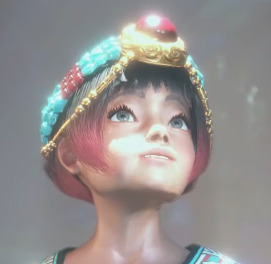

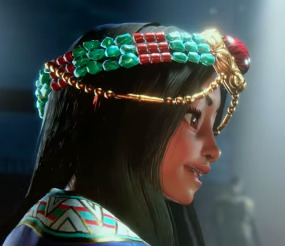
Tibetan headdresses vary by region, age, and marital status. For example, unmarried girls wear a single braid with a red hair string, called Xia Jiu in Tibetan.
Tibetan women wear headdresses on special occasions, such as festivals and their comings-of-age. Headdresses can be colorful and made of coral, turquoise, or other materials. For example, a "Bazhu" is a deluxe headdress made of coral or turquoise with gold or silver earrings. Tibetan women also wear silver bracelets on their left hand and white conch bracelets on their right.


Jewelry


Tibetans traditionally wear jewelry, which is often made from gold, silver, and precious stones. The most common gems used are turquoise, coral, and pearls, which are used in necklaces, earrings, hair ornaments, and to decorate ritual objects. Tibetan jewelry can also be made from cow bone, amber, shell, and agate.
Tibetans wear a variety of jewelry, including ornaments made of gold and silver, as well as jewelry made of amber, agate, jadeite, pearl, and ivory. Tibetan jewelry traditionally features materials from across South Asia, East Asia, and the Middle East, and the symbols on Tibetan jewelry are usually from Himalayan Buddhism. Tibetans like to wear many ornaments and jewelry, such as Buddha beads, hair bands, hair accessories, belts, prayer beads, and necklaces.
Jewelry is a symbol of status and wealth in Tibetan culture, and each design has a specific meaning. For example, ornaments with symbols of animals, flowers, and stones are often given to commemorate special occasions. Some also believe that wearing gold enhances spiritual power over evil spirits. Offering jewelry to holy statues is thought to generate positive virtue for the donor.
This article also goes into the types of ornaments they use in their jewelry
Jewelry can also serve as a talisman, with different amulets protecting against disease and harm. For example, coral and turquoise are said to ward off evil spirits and illness.
Many Tibetan jewelry pieces are passed down from generation to generation. For example, some Tibetan-style pendants are used in Buddhism as ritual instruments to subdue demons, which are believed to dispel sins and bring people power, intelligence, and courage. Many of these pendants also have Sanskrit inscriptions of a religious symbolic nature.
Braids
Braids are also a symbol of strength, wisdom, and identity for some indigenous men and boys. They can also represent a connection to the earth, ancestors, and the creator. For example, in Native American tradition, hair is a signifier of spiritual practice, and braiding demonstrates strength in unity
boots
sumba shoes



Tibetans typically wear boots, which are more cultural representations than practical clothing. However, due to the prevalence of mass-produced shoes, traditional Tibetan boots are no longer the daily footwear for ordinary Tibetans. Instead, they are now usually part of ceremonial attire.
Tibetan boots are a significant part of the Tibetan way of life. They are more cultural than practical, and are worn to represent different regions and environments. For example, boots with a pointed toe are suitable for different types of terrain, and can be worn with a garter in cold weather. Boots from different regions of Tibet have different styles and qualities. For example, boots from Chamdo and northern Tibet are simple, while boots from Shannan and Xigaze are more delicate.
Tibetan boots are commonly made from cowhide, pigskin, corduroy, and pulu, a traditional woolen fabric. Other materials used include cloth, canvas, velvet, leather, and felt. The original boots were made from yak hide, and the soles were embroidered with patterns like dragons and snakes, and the shoes were decorated with red and green woolen cloth.
Tibetan boots come in two general types: short leg and long leg. Most Tibetan boots are lined or padded, though some may be unlined. The heads of corduroy boots are made of cowhide, and many kinds of pulu boots have cowhide soles.

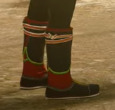
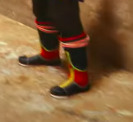
16 notes
·
View notes
Text
A big review of Sakae Esuno's 'Big Order,' Part 1: The Actual "Review" Part
It begins.

This all began with a simple ask from @bluescxrs, but I've definitely made it grow in my mind since I received that request. What began as "Can you outline the story differences, particularly in relation to Eiji/Rin" became me thinking "I should make that just one part of a much larger, thorough review."
So for a while now, I've been sporadically writing parts of this post while simultaneously asking myself "How do I even do this?" More specifically: How do I review a manga AND an anime that are so different from one another? How do I explain the differences between the mediums without proliferating tons of spoilers? And is that even really part of a standard "review," or does this need to be multiple posts?
My ultimate conclusions are that I need to treat this like any other anime review I've put together on my main Tumblr. I think going deeper on what separates the two versions of "Big Order" is going to require its own post with more spoilers, though.
I'll just be upfront about this,, and state what any regular readers of this Tumblr probably already know: I've come here to praise "Big Order" as a manga, and to be less kind to its anime incarnation.
Background/Behind-the-Scenes
In case you didn't know, Big Order was Sakae Esuno's follow-up manga after he struck gold with Mirai Nikki/Future Diary. I'm sure he was feeling the pressure to produce a worthwhile follow-up after he hit it big with that one. But thankfully, Big Order was a successful series for Monthly Shōnen Ace. At least it was successful enough to run for almost as long as Future Diary did and get collected into 10 volumes. Kadokawa has never shied away from ending a series early if it fails to catch on, so that speaks well to Big Order's reception. Admittedly, it never generated the same numbers or level of passion among its readership. But as Esuno himself has said, a mangaka is lucky to create even one series as beloved as Mirai Nikki. And it's not like Big Order didn't have devoted readers of its own — especially in Japan, but to some degree also in China and parts of Europe.
It never made much of an impact on the Western hemisphere, though. Mirai Nikki's success in America and much of the Western hemisphere came largely in the wake of its popular anime adaption. I can't speak to how well Big Order did as a scanlation. But unfortunately, the manga wasn't officially published in North America until AFTER its anime adaption had finished airing... to pretty much the opposite of acclaim.
The anime was produced by the same studio that adapted Future Diary a few years earlier: Asread. Although Esuno has stated his overall satisfaction with the anime adaption of Future Diary and said that he sat in on some story meetings to see how they were adapting the manga and provide some feedback, I've never seen him comment whatsoever on the anime adaption of Big Order. In fact, I don't think I've ever read or seen any interviews that were conducted with him since post-2015! The closest I've ever seen him come is confirming that they were developing an OVA prior to its eventual release in late 2015. That's it. As such, we have no idea how involved he was or wasn't with the development of Big Order's anime, nor do we know what he thinks about the end result. I don't want to assume his feelings... but I have to imagine that they're less positive than his opinion of Future Diary's anime.
We'll circle back to why I think that at the end of this post, though. For now, let's dig into what this series is actually about.
The First Chapter/Episode's Plot Setup
Ten years prior to this story, everything changed. A massive cataclysm struck the globe that killed approximately 3.5 billion people... about half of the world's population. At the same time, the world saw the appearance of the first "Orders" — people with supernatural abilities that can be activated verbally, or sometimes just mentally. People become Orders when when a floating, intangible fairy-like girl named "Daisy" appears to them and grants them a single wish. The Order's ability is based upon how Daisy interprets their wish... but no one who isn't an Order or potential Order can even see Daisy, so how or why these superpowered individuals come into exist remains unknown to the general public.

Daisy's first appearance before Eiji.
In the aftermath of that disaster now known as "the Great Destruction," the majority of the world's governments collapsed. It fell to the United Nations to create and establish interim governments and oversight councils as a way to maintain a semblance of order. Most of these governments are led by Orders who are put under the U.N.'s well-paid employ, with their supernatural abilities serving as a means to both maintain local control and enforce the law among normal civilians.
Eiji Hoshimiya is our focal protagonist. He's an 18-year-old high school student who lost his parents in the cataclysm 10 years ago. To make matters worse, he's the very person who accidentally caused the Great Destruction — an unintended side effect of his wish to "dominate the world" running amuck. Yup, Eiji is an Order, although he's sworn off ever powers after what happened back then and kept the secret of his guilt to himself. After both his parents died in the Great Destruction, Eiji's main focus has been to simply give his terminally ill stepsister, Sena, whatever joy and attention he can manage to provide during the limited time she has left. When our story starts, she supposedly has just six months left before a rare form of leukemia takes her life. And once Sena passes away, Eiji's fine with accepting whatever punishment come his way for his actions 10 years ago. He only wishes to hide his guilt for as long as it takes to keep Sena smiling.
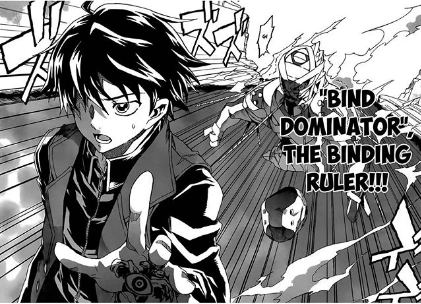
A symbol appears on the user's palm whenever they invoke their Order ability, which also calls forth a "stand" or "avatar" figure that embodies and ultimately enacts the user's Orders. Just like Daisy, these avatars are only visible to other Orders.
(This is a VERY LONG post, so I'll put the rest under a cut for everyone's benefit.)
Rin Kurenai is our secondary protagonist despite the fact that she's also something of an antagonist — a dichotomy that's certainly famillar to anyone who's experienced Future Diary. When Rin shows up at Eiji's school one day, Eiji immediately crushes on her. Unfortunately for Eiji, Rin isn't the sweet new transfer student she initially appears to be. In reality, she's an Order that's come to this school to fulfill a personal vendetta. After spending 10 years working training herself up while trying to locate and identify the person who caused her parents to die in the Great Destruction, she's finally arrived at her chance for vengeance. Her sole dream stands before her: A chance to kill Eiji Hoshimiya.
Some facts to consider about how Eiji and Rin's Order powers work:
Eiji's power of "domination" lets him control absolutely anything within his "domain," which is defined as anywhere he's been + a surrounding radius of roughly 2 meters. This domain ALSO includes anything vertically aligned with that same space/radius. (In other words, if he walks the entireity the first floor of a three-story building, he now can control anything that happens on not only the first floor, but ALSO all the same spaces above him on the other two floors. Or if he flies above the ground, he can now control the ground directly below that airspace. Get it?) Oh, and his control/domination isn't limited to just giving orders to people and/or creatures within that space — he can literally control the laws of physics if he so wishes. He basically controls reality itself within his domain. But importantly, the moment that something he's controlling leaves his domain? He loses all power over it. And he can do nothing to anyone or anything that never enters his domain.
Rin's also an Order, and her power is regeneration. Whenever she so wishes, she can heal herself as well as anyone and anything within arm's reach. This allows her to repair broken weapons or heal wounded allies, of course, but it also auto-triggers any time she dies, reviving her in seconds. This renders her effectively immortal.
Given the above facts, when Eiji is faced with a relentless immortal assassin whose only wish is to kill him by any possible means, he makes the decision to use his powers on Rin by giving her two consecutive orders:
Order #1: Rin can never harm him or his sister.
Order #2: Rin can never leave his domain. (Because if she did, she'd break free of Order #1.)
Just like that, our lead characters are thrust into an unlikely, antagonistic "partnership."
But wait; there's more!
If you're wondering how Rin knew that Eiji caused the cataclysm? That's because she's an agent of the Ten Hands — a group of ten powerful Orders who made up the interim U.N. government of Kyushu... until now. Because when Eiji and Rin wind up at their headquarters in Dazaifu, it turns out that the Ten Hands have just declared they are the next evolution of humanity and intend to rule the world. (If you're familiar with the X-Men? Just picture Magneto's Brotherhood of Mutants :P). Rin's went rogue even from THAT rogue organization, though, because Ten Hands wanted her to capture Eiji alive! They're after Eiji because his powers are useful to them AND he makes the ideal figurehead/decoy to front their organization. Once they declare war on the United Nations in Eiji's name (going so far as to include the public announcement that Eiji is the one to blame for the disaster of 10 years prior), Eiji find himself forced to cooperate and act as the figurehead/puppet ruler of the Ten Hands. Where else can he go when he's now the most wanted and hated person on the planet?

A spread giving an overview of the Ten Hands, aka "the Group of Ten."
But as an extra carrot-on-a-stick, the leader of the Ten Hands — Colonel Hiiragi — reveals to Eiji that they've kidnapped Sena. And he then suggests that if Eiji expands his influence over the world, he should logically eventually locate an Order that could cure Sena of her terminal illness.
So wait, what kind of story is this?
For me, the primary joy of Big Order's main plot comes from the characters constantly working to out-manuever and out-manipulate one another. This is often done in the form of Order "battles," sure — but rather than being about who can hit one another hardest with a superpower, those battles are still fundamentally about pulling tricks, feints, and ultimately out-manuevering someone.
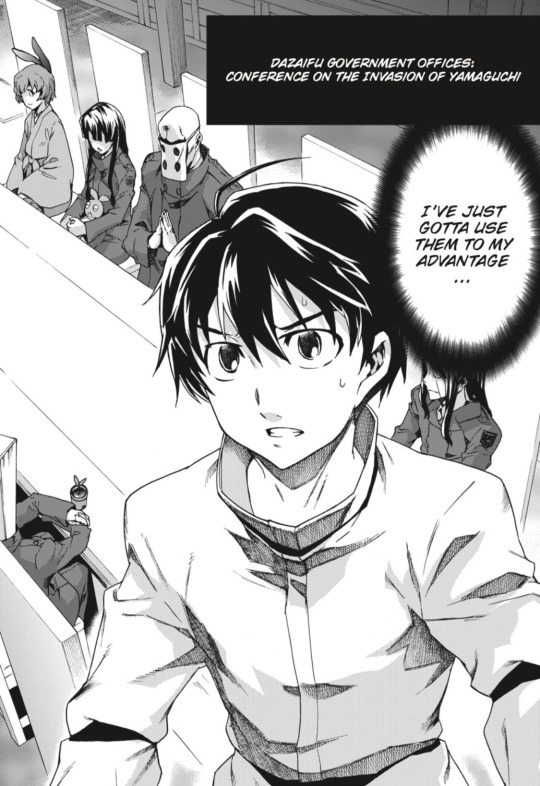
Eiji thinking what EVERYBODY in this story is thinking, essentially.
You can see it built into where the setup I described above leaves off. See, it's like this:
Because the Ten Hands has already announced Eiji as their leader and the cause of the great destruction PLUS they've got his sister, he is blackmailed into becoming their figurehead leader.
To try and counter this, Eiji swiftly places his domination order on every member of the Ten Hands, giving him the ability to control them individually while they're inside the base — providing him with leverage. IN THEORY.
But what he (and we) don't initially know is that Colonel Hiiragi had already put his own unique Order in place that covers the same base, and Hiiragi's power completely counteracts Eiji's control of the Ten Hands' people. (Hiiragi's power does NOT, however, counteract Eiji's control of the objects, air, physics, etc. within the base's property.)
But there's another complication to consider: One of the members of the Ten Hands is using his ability to stop time to freeze Sena, preventing her disease from progressing. As such, anything Eiji does to attack within the base or undermine the Ten Hands' plans will obviously cause that person to unfreeze Sena, returning her lifespan to a ticking clock.
With all that going on, Can Eiji really do anything to push his own agenda and exercise his free will? That's just ONE example of the complicated tit-for-tat thinking that makes up so many of Big Order's character interactions and confrontations.
Eiji and Rin's relationship is a microcosm of this stuff. Eiji knows Rin can't kill him thanks to his Order ability, but he also knows that she's foolishly obsessed with killing him personally to the point that she refuses to let anyone else have that pleasure. As a result, the person who hates him the most also becomes the person he's most able to trust. But that doesn't mean Rin's ready to give up on trying to trick him into a not-quite-accidental death, either. There's a push and pull to their mutual trust-laced-with-distrust.
Even within the Ten Hands themselves, there are a couple members who turn out to have more faith/trust in Eiji than they do in Colonel Hiiragi. Hiiragi's mission is ultimately somewhat compromised by his need for personal vengeance, whereas Eiji manages to gain faith and trust from some of the members based on how he indepently handles some things. All these personal motivations, unique powers, and relative/comparative intelligence mix to make a stew of actions and counteractions that I greatly enjoy reading. And by the time the story starts to move away from focusing on these complicated showdowns, you're far enough in that you should (hopefully) be attached to some of its characters already.
The Narrative and its Characters
From a writing POV, it's worth noting that Sakae Esuno took a different approach to writing Big Order as compared to how he wrote Mirai Nikki/Future Diary. See, Esuno had a pretty strong outline for the story when he started making Mirai Nikki. (Actually, he says he created two outlines for Mirai Nikki: One for "I get to write the full-length story" and one for "I have to wrap things up quickly because the series gets cancelled early.") However, on Big Order, Esuno opted to only plan where the story would go in a much looser, vaguer way. He said he wanted to leave himself more leeway to explore whatever new ideas he thought of as the story developed, not constrain himself so much to a tightly pre-planned narrative. I'm not telling you this as a form of judging his choice negatively, though; I can see the appeal to both approaches. I'm just telling y'all this because I think those differences in approach are sometimes noticeable.
There are occasionally pieces of info or hints within the manga that don't seem to go anywhere, and you might even notice some of these are dropped entirely in the anime. A prime example: The early chapters of the manga have Sena referencing that the doctor working caring for her at the hospital is her and Eiji's uncle. Whether she's speaking literally or somehow metaphorically, this never goes anywhere. Heck, we never even see or meet that character! So it's understandable that those references are left out of the anime. It doesn't feel like it's some lost subplot that was left hanging, but it's just the kind of detail that feels like it might hold meaning down the line... yet never does. Those sorts of "dead-end details" get increasingly rare the longer the manga goes on, however. The story grows leaner and tighter as it nears its end.
Beyond that, this story has all the hallmarks I've come to love about Sakae Esuno's works: Tons of plot twists (much more in the manga), the ability to vascillate wildly between darkness and comedy, engaging psychological underpinnings to the characters (mostly in the manga), a twisted focal relationship... it's all here. What's not to love? Well, I suppose Big Order and Future Diary share one weakness: Despite both stories supposedly having a global impact, the entire story stays isolated to Japan. Future Diary justified this with some passing text explaining that Deus has intentionally developed or lured his future god prospects into one area. Big Order's justification is that the entire "Great Destruction" was caused within Japan due to research taking place in Japan. Perhaps not as strong of an overall driver for the localized focus, but it works decently enough.
So let's dig a little into that "twisted focal relationship." Despite what I said previously about Rin and Eiji's "dual protagonists where one is also kind of an antagonist" dynamic being similar to Future Diary's Yuki and Yuno, these characters almost feel like counterpoints to the leads of Mirai Nikki. Although Eiji visually looks a lot like Yuki and Rin might initially give off Yuno vibes thanks to her aggressive nature and twin hanging hair-tails, they're each more unlike their Esuno-created predecessors than they are similar to them. And so — as I said in that old post I just linked to — Eiji and Rin almost feel like a reaction/response to Yuki and Yuno, intentionally designed to flip or trade off a lot of their individual traits while still maintaining a select few similarities.

Rin's blind rage at Eiji can make her kind of a moron at times. Delightfully so.
Both of them get to grow and change a lot over the course of the manga's story, though they don't get anywhere NEAR as much growth in the anime. The ten or so manga chapters following the end of the anime are particularly good for Eiji, who goes through a period of trauma-response depression that's very well-portrayed IMO. I think him already being in his mindset helps him cope with the wild perception-warping crap he sees and experiences shortly before the final stretch of the story kicks in. Rin's growth is more gradual; at first, she's just forced to gain some empathy for the person she's spent a decade hating. That helps her to eventually shift her desire for revenge onto other parties. But in the end, she gets smarter AND kinder, learning to let go of her desire for revenge and legitimately finding a way to forgive something that once seemed unforgivable. It's actually touching, IMO.
But you know, Yuki/Yuno's relationship never got a strong outside competitor. Let's face it: Yuki never showed any interest in or attraction towards Akise, regardless of Akise's own feelings. On the flip side, the Eiji/Rin relationship actually gets a pretty strong third party thrown into the mix: Iyo.
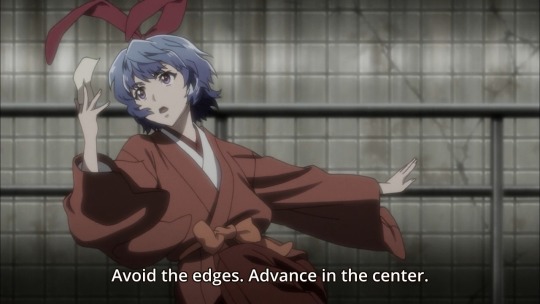
Iyo! No surname needed, evidently?
If there's a tritagonist in Big Order, it's Iyo — a member of the Ten Hands' leadership who demonstrates fr more compassion thant he rest. Iyo's a shrine maiden/miko whose Order granted her the power to predict the future with 99% accuracy by asking any question to the heavens, summoning a slip of paper that provides the answer. The downside to this is that whenever someone acts upon her predictions they are inherently changing the course of fate, so their actions will affect whether the prediction remains true. And for Iyo, that's a personal matter: Her very first question to the heavens (and thus the first prediction handed down to her) was to find out who her future husband would be... which is when she learned that she was destined to marry Eiji Hoshimiya and bear his child. This prediction + Eiji's natural kindness towards her are two reasons why she finds herself swiftly infatuated with Eiji as soon as he aligns himself with the Ten Hands. And thus, Iyo winds up being the third spoke in a love triangle that also includes Eiji and Rin. But she's not hanging around just to undermine or irritate Rin, because she proves to be an invaluable partner to Eiji's goals in her own right.
I adore both Iyo AND her twitchy bunny-ear head-ribbon. Part of me can't help but want her to win Eiji's heart, because she deserves the world. However, because her infatuation with Eiji is driven by her prediction, her attraction to him is kind of questionable IMO; does she only fall for Eiji because she was told that she would by her powers? Regardless of the reason, her feelings drive her to try and spend more time with him/get closer to him. The knock-on effect, however, is that because she's acting upon her own prediction, that means her actions have every possbility of destroying/altering the very future she's pining for.

The writing here definitely favors Eiji and Rin as the core couple, but unlike Future Diary, Big Order isn't going to give you a clear-cut answer as to who the characters wind up with. Future Diary wound up cementing Yuno and Yuki's relationship canonically because, well, that was the whole point of the thing. The central Yuki/Yuno relationship was the absolute core of Future Diary's narrative, but conversely, the Eiji/Rin relationship isn't the most important relationship in Big Order. It's a major focus, sure, but it's not propping up the entire narrative — which I think is why Esuno feels no need to canonize it. Although the story definitely seems to favor Eiji/Rin, neither the manga nor the anime explicitly state who Eiji winds up with (if anyone).
Instead, the core relationship that's propping up Big Order's story is a familial one: The one between Eiji and Sena. Sena is the stepsister he didn't think he wanted and who he was initially hesitant to get to know. Ultimately, however, she won him over with her warmth and sweetness. When their parents were killed in the Great Destruction, Eiji wound up isolating himself from everyone BUT Sena. Which is a big reason why Eiji's ultimate goal is merely to protect her and give her happiness for as long as she lives (which, as previously stated, is currently expected to be only six more months). It definitely calls to mind Yuno's own simplistic goal of "one day of perfect happiness," etc. But while Yuno's goal is inherently flawed, Eiji's is theoretically possible... right up until the Ten Hands ruin it. Because just a few chapters into the story, they start telling her all kinds of shit that Eiji had been trying to hide from her.
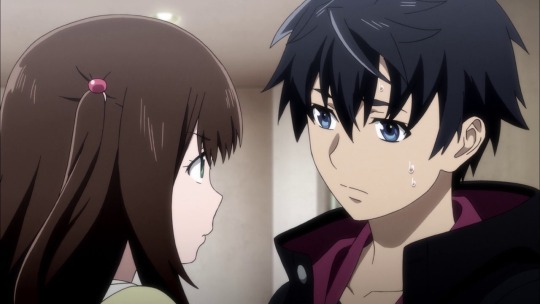
Sena starts out as little more than a background MacGuffin, but she isn't content to stay on those sidelines. Once she has agency to do so, she starts participating in her brother's struggle despite this being against pretty much everybody else's wishes. Her unwanted intervention makes for a pretty fun spanner in the works of the story... but I'm not going to get too specific about it. I think it's really fun to watch her fight back against her own "MacGuffin" status — too much fun for me to spoil how it all happens.
Anime vs. Manga: The Short Version
The anime adapts the first 32 chapters of the manga over the course of its ten episodes. MOST of the major plot beats are the same, at least. But along the way, there are LOADS of scenes altered in small ways, as well as some added and some entirely deleted. And of course, once it reaches the final episode? There's a new ending and denouement so that everything stops there. They do not leave anything open for a possible future season that would adapt the remaining 22 chapters of the story — those are simply ignored.
Now yes, the anime aired while the manga was still ongoing. But... the manga was also MUCH farther along than the anime would lead you to believe — 50 chapters had already been published when the very first episode aired! So the decision to cut the manga's story off at Chapter 32 is definitely a weird one.
To briefly summarize the most common changes made to the first 32 chapters in the process of turning them into 10 anime episodes, it's like this:
The anime turns the nudity / sexual content / fanservice WAAAAAY the fuck up. Like, a simple hug in the manga becomes grinding/dry-humping in the anime. A girl in full clothing in the manga will become a girl in a very loose-hanging dress with most of her body exposed in the anime. And, look — for better or worse, Esuno is no stranger to tossing female nudity into his manga, either for some pointless fanservice or sometimes to further accentuate the horror on display. But even the most fanservice-y manga scenes are extended and expanded upon a lot in the anime.
Ton of background information that provides foundations for how things work in this world is removed. The manga often ends a chapter with an info page providing details on a supporting character's backstory or how one specific powerset works. These are the kinds of lore-dumps that are often used as screens that frame commercial breaks in a lot of major anime (Attack on Titan and My Hero Academia both have done this). In Big Order, however, the framing cards for ad breaks are just pieces of art, and no attempt is made at providing any of these additional details in any format. They're just left on the cutting-room floor, which I think definitely makes a lot of things both more shallow AND more confusing.

An example of one of these "data pages" within the manga.
THE MOST IMPORTANT CHANGE OF ALL: This one bullet could be an entire essay of me complaining ALL BY ITSELF, but I'll try to keep this brief: In the manga, a number of characters point out that Eiji and Sena aren't actually related by blood, so they theorize that maybe their relationship is somehow romantic/sexual etc.? This suggestion is always shot down by a disgusted Eiji, who will usually insult the theory/theorizer while explaining that being "family" isn't just about your blood ties — but regardless, Sena is absolutely his family, and so on, because she's always had his back. And it's sweet. They are willing to do anything to support one another, even when they see the other one headed in the wrong direction, but it's always very pure and warm-hearted and UMMMMMMMMM, the anime goes in the exact opposite fucking direction. These stepsiblings are absolutely fucking one another in the anime. I cannot and will not ever understand what drove them to do this. Whatever the reason, this is SO antithetical to the manga's point and the central relationship of the story that it does a good job ruining the anime all on its own, even without the other changes... and that's without me touching upon the ethical question of 18-year-old Eiji fucking the 13-year-old Sena. One of the weirder aspects of this ill-advised change is how this whole new subplot has NO impact on the rest of the story! The scenes of them being sexually/romantically involved contain no voice work, for one thing. But also, some of the scenes from the manga where he angrily denies his relationship with Sena being like that are still present in the anime. But I guess now they're just really aggressive lies? He literally beats up one character for suggesting he might be attracted to Sena. Which works great in the manga, but now it's like.... wtf? Also, Eiji having feelings for/involvement with Sena *never* comes up when he's dealing with his relationship with Rin or Iyo — he's still flustered by the idea of sex with anyone or being close to a cute girl, etc. It really comes across as though Asread just kinda inserted this gross shit without telling anyone outside of the animation team directly involved with the new scenes.
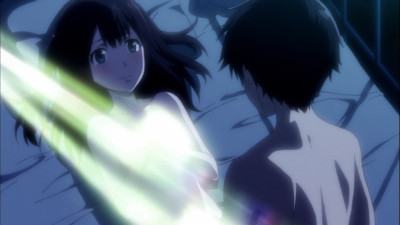
WHY, FUCKING WHY WOULD YOU DO THIS
Suffice it to say that for as much as I love the suspense and twists of the manga, I can't recommend its anime incarnation unless you just want to see the characters (1) in full color and (2) in motion. It makes a somewhat amusing side dish to the manga, but it's a very poor substitute.
But I'm going to get somewhat more in-depth about all the differences between the two in my next post on the subject, which will include sharing some spoilers about what happens AFTER Chapter 32 in the manga. It's a big enough task that I think it deserves its own separate writeup. And lord knows that this one is already long enough. :P
#big order#sakae esuno#manga#review#rin kurenai#eiji hoshimiya#sena hoshimiya#mirai nikki#future diary
8 notes
·
View notes
Note
🔥 Batman comics in general
Send me a “ 🔥 “ for an unpopular opinion.
Oooh! I do think a lot of my saltier Batman comics opinions aren't exactly unpopular in nature (too much grimdark and never in the right direction, the misogyny, Killing Joke was a mistake, BruceBabs was a mistake, stop misusing Rogues), so I'll try to bring up some less-discussed ones! (Or at least ones I see discussed less, lol.)
Batfam is conceptually good, but nobody is handling it well. As I've previously expressed, Batfam content constantly oscillates between "Bruce is an abusive kidnapper of traumatized children he trains into child soldiers despite having the means to have them live in luxury, does not provide with love or positive reinforcement, and regularly pits against each other" and some of the most facile, cringey, early 2010s Tumblr conception of found-family to be seen, when I think it's more dramatically effective to find a happy medium between the two. A loving superhero found family with its share of dysfunction, hurts, and mistakes and appropriate nuance being brought to these conflicts is apparently too much to ask for (as is writers remembering Robin(s) and Batgirl literally exist as kid appeal characters).
Likewise, canon Harlivy is seldom handled well. As I said on Twitter the other day, "corporate Pride ate Harlivy". Harley Quinn and Poison Ivy's relationship, both back when it was subtextual and later on as it became Harley's main ship in iterations where she's able to get out of her abusive relationship with the Joker was groundbreaking and important. It was absolutely crucial to middle school me. But somewhere along the way, people lost the plot that they are indeed villainesses (whose queerness was meant to make them more endearing/sympathetic/relatable, but not change this status), and it fell prey to the respectability politics traps that plague just too many sapphic ships once they go canon. In order to be 'good representation', their villainy extends to 'haha RANDOM' irreverent chaos, and their personality gets boiled down to the shallow archetypes of 'chaotic and perky' Harley and 'snarky and sexy' Ivy. Their relationship to one another is 100% fluff, because God knows any nuance, tension, flaws, or friction between two master criminal characters with canonically tragic histories can't possibly be allowed. Because of the misogynistic expectations of Women Being Soft And Good coupled with the homophobic respectability politics of being as toothless, soft, and desexualized as possible to appear nonthreatening, sapphic ships are held to such unfair standards wherein the slightest conflict will be termed abusive and bad representation, and as such, they're written cardboard-flat, and unfortunately, this has befallen Harlivy in most canons where they're together. Even if it's realistically exploring things like recovery for either lady, because that's messy, and complicated, and nonlinear, and who wants that when you can have a memeable 'be gay do crimes'? Oh, but don't worry. Sometimes they will be sexually active - for the titillation of straight men. In-universe. (Don't get me started on the Harley Quinn show...) And poor Selina gets roped into third-wheeling/cheerleading the most boring possible version of them too often...
A lot of the most popular/famous titles are not the better ones. (Not you, Long Halloween, you're a delight and everyone loves you.) Everything that's there to say about The Killing Joke and The Dark Knight Returns has been said better by people smarter and better-versed in comics than me, but Batman: Hush is just contrivance upon contrivance, everyone and their mother is tired of the shit-billion stories about Joker fridging yet another person, and perhaps my most unpopular opinion is that Batman: Year One is entirely overrated. I like the noir atmosphere, the truly corrupted Gotham it gives us, and the sweet triumvirate between Gordon, Harvey, and Bruce, but seeing adaptations like The Batman (2022) and even The Dark Knight (yes, I'm saying something nice about Nolanverse for once lolol) take these elements and do so much more with them really highlights the weaknesses in this story. There's some really good origin/character work for Bruce becoming Batman and the psychology behind it, but past that, not a whole lot happens beyond a very thin and confusing police corruption plot, and everyone is just too damn mean for the sake of the grimdark setting. Bruce injures an already exploited child in the red-light district and sexually harasses the Gordons to throw them off his trail for being Batman, and the latter is played for laughs. Jim cheats on his pregnant wife with a coworker half his age and both women are portrayed as stereotypically in these roles as humanly possible. Selina Kyle is...there, to be angry and sexualized and not much else. It just feels like a lot of buildup without much payoff.
Lastly, and jumping off the above, I'm taking away the Gordon family from writers until they've learned to play nicely with them. I don't know what it is about Jim Gordon that makes writers - men in particular - work through justifying their weird issues about women, but my God, the poor man has been character assassinated to hell and back. (Everyone has in comics, but it's always in the same way with Gordon that properly grosses me out.) If he's not cheating on his housewife with a much younger coworker he's presented as oh-so-noble for not outright workplace harassing, he's neglectful, abusive, or otherwise aggressive to his loved ones in ways that are almost always justified or excused narratively because he's 'dealing with a lot' or xyz past trauma. He's frequently made into a mouthpiece for misogyny, calling women "bitches" in the Arkham series and making other such delightful comments, fetishizing Harlivy (in the Harley Quinn show!), or putting down Barbara's capabilities. If he's written to be struggling with addiction, it's always played as a joke. And for Barbara's part, since The Killing Joke, she's always such a favoured writers' punching bag/doll to put in uncomfortable relationships, often having her talents, skills and intelligence undermined in favour of portraying her as a sex-crazed, overemotional disaster who's in it for the thrills until she is narratively punished in some gendered way. I don't get it! I'm all for what makes characters tick or challenging them or giving them flaws or new horrific situations to work through, but why is it always the same tired, offensive hows and wherefores for the Gordon family? Let them rest!
33 notes
·
View notes
Note
3, 5 and 14 for the fic asks 😁
Thanks for the ask!
3. What’s your favorite fic that you’ve written?
Oof. Starting off with the hard hitting questions. Let's go with a more comprehensive answer this time, which is to say one answer per fandom that I've written more than one fic for.
Black Sails: Reclamation. It's got themes and I'm really proud of the way that it manages to let the characters not be perfect people.
James Bond: I think my favorite in this one has to be Classified Action. It's a feel-good with a nice little crossover from one James Bond series to another.
Fate the Winx Saga: It's Dance Night. I know it got less than a hundred hits, I know it's not popular, but I really actually love this one.
October Daye: Many a Good Hanging. I know I haven't finished it, I know it's sitting there languishing, but you guys. Y'all. you don't get it I know what the end of this one is and the mental image makes me gasp in pain still even though it ends happily for just about everyone. I love the potential of this one if I can ever get my brain to write more of it.
5. What’s a fic idea you’ve had that you will never write?
You know, I considered this for hours and legit could not come up with anything because usually if I have a fic idea, I just go ahead and write the silly thing, even if in the end it turns out to go nowhere.
14. If you could see one of your fics adapted into a visual medium, such as comic or film, which fan fic would you pick?
Any of them. I've been told in the past that my fics feel like films, so probably any of them would do well that way. I'm not so sure about comics but if anyone wants to try it as fanart, please feel free!
4 notes
·
View notes
Text
Norakuro & Atemporality

Norakuro Manga
This was a really interesting manga. On the surface level, it’s just a cute manga most likely aimed at children about dogs and pigs fighting. But once I look at the year this was released I began to think about what was truly the purpose of this work. It’s possible this kind of theme became popular as a way to get the public more on board with the idea of going to war and romanticizing victory. If it’s true this manga was made with that in mind maybe it should be considered alongside other media created for the purposes of entertainment and indoctrination. Especially when it comes to the scenes of the planes fighting and getting into a collision, it just seems eerily similar to the use of kamikaze planes. The end when the dogs celebrate by saying how they will make a “wonderful country”, is reminiscent of how the Japanese attempted to take over Taiwan and other parts of Asia, overall trying to become the most dominant Asian country. Overall, I think there’s more to this work than initially meets the eye.
Atemporality
This work brought up ideas about manga I had never considered before. I previously never gave much thought to how movement is expressed in manga, but in works like the Norakuro manga it’s clear how important something as small as speed ine can be when explaining what's happening in a picture with very little text. Additionally, I’ve never thought about how mangakas choose to demonstrate time in their works and how this relates to the medium it will be adapted to later. The discussion of atemporality was also interesting as I never considered the impact of keeping things so consistent like age’s, tournament arcs etc. I can see how techniques like this lead to shows being considered classics and comfort shows so to speak because you always know what to expect but not in a boring way. Overall, this reading introduced concepts concerning manga and anime I had never considered but definitely play a huge role in making them as popular and digestible as they are today.
Norakuro Video
This video was interesting in the sense that it shows how much anime has progressed from its humble beginnings. Comparing this video to modern anime obviously, the characters are much more dynamic and less stagnant. But even so, it was still impressive how much personality some characters like the black dog were able to express from just their accent and the way they phrased things. Like what was said in the previous reading, if a personality is too complicated, the narrative will be as well therefore it’s better to make the personalities of characters obvious. And I definitely saw that come through when it came to the monkeys. It was also interesting to see how movement was expressed, mainly through shading to create a shadow on the ground. Overall it was interesting to see how the techniques previously mentioned come together within one work.
3 notes
·
View notes
Text
So while working on a drawing WIP of mine, I was watching a video from Drew Gooden on the Avatar Netflix adaption (note: I have never seen Avatar: the Last Airbender, and I don’t particularly plan to, either; I am just a fan of Drew Gooden’s videos and I like to learn about various series I will probably never and honestly have no desire to directly, personally interact with), and I think that he perfectly summed up in very short terms what I mean when I say that the Fifteen anime and manga are both poor adaptions of the original story.
[Transcript: “Now, before I continue getting mad about every single aspect of this show, I do wanna answer a more general question of like, ‘what should we expect out of an adaption?’ — because it may sound like I’m trying to say that this should have been a one-to-one recreation of the original show, when that is not the case.”
“You can, and should, be able to change things; why even bother spending all this money to make something that looks worse, if it’s going to be exactly the same? But, those changes need to enhance the story; they can’t be at odds with the spirit of the show, or fundamentally change a character.” /end Transcript]
While I still need to finish my article on Fifteen and its anime adaption, and later better address the manga, this is the point I want to hammer home to people who refuse to get the position I am coming from:
I am not saying that either the manga or the anime would be bad in and of themselves if they were wholly original stories, or that there is anything inherently wrong with adding content that was not in the original source material.
I am saying that they are bad at being adaptions; they are bad at representing the pre-existing story they are supposed to be telling in a new medium. While they could be perfectly fine and serviceable — if, in my opinion, far less compelling — stories if they were original content with no previous source material to adapt from, they are not that, and that is what makes them bad. They are horrible representations of the story they are trying to tell, and for an adaption there can be no greater failing than this.
The biggest changes that were made to both the anime and the manga do not enhance the story.
They do not fit the spirit of the source material.
The anime fundamentally changes a major character and re-writes an entire scene and major plot points in order to allow them to have an excuse for a few seconds of cheap fanservice for a popular pairing/character — which could have still been had in an even better way without mutilation in a different scene they actively decided to remove in order to save time that they completely squandered anyway.
The manga in certain crucial chapters takes visual creative liberties that do not at all fit the spirit, tone, or descriptions within the source material in order to play up a horror aspect that very simply was not intended to exist in the first place, and in doing so fundamentally alters important characterization, along with unnecessary and tone-altering tweaks to a few choice lines of dialogue.
An adaption should be just that: an adaption, not a re-imagining, not a re-telling, not a re-make; its job is to tell the story and elevate it as much as possible using the unique perks of the specific medium it is being brought into. For both anime and manga, this should have been done through the use of visuals (and in the case of the anime, movement, music, and voice acting) to bring the scenes described within the original source material to life and fill in the blanks based on the rest of the picture painted there, as well as expand on certain points and add to them using the spirit of the original story.
Both the anime and the manga have times when they prove that they can do such things quite well and quite efficiently, but then utterly fail to do at some of the points where it matters the very most, and that is why it can’t and shouldn’t be forgiven.
It is not a matter of not being one-to-one with the original with every scene, it is a matter of completely ignoring the most fundamental and important aspects of some of the very most crucial ones of those scenes in favor of “doing its own thing”, even if it means completely ignoring the points the original source material — and the adaption most closely worked on by the original creator (the stage plays) — tried to make.
#linklethehistorian#my thoughts#thoughts#bungou stray dogs#bsd#bsd novels#fifteen#bsd anime#bsd stage play#fifteen manga#fifteen stage play#season 3#bsd arthur rimbaud#randou#I know I’m talking to a wall but seriously people need to realize that adaptions are supposed to be adaptions#and that the moment it fails to be that yes it is in fact a bad adaption no matter how much you enjoy it as its own thing#you can enjoy it as its own thing if you must and still understand and acknowledge that it is a bad adaption#an adaption that does not adapt a story to a new medium but rather changes it in unnecessary ways that do not elevate the original is#not an adaption#but a failure of one#as at that point it has become a complete reimagining#and reimaginings are not bad….but they are if that was not what they were supposed to be doing in the first place#and if they aren’t upfront about the fact that it is NOT the same story but only borrows parts of it
3 notes
·
View notes
Note
okay, I’ve never seen Rings of Power and have no plans too, so talk to me about adaptation theory please??
absolutely, this is one of my areas of academic interest!! :D i'm mostly going to be discussing robert stam's beyond fidelity and thomas leitch's twelve fallacies in contemporary adaptation theory because they're available online, relatively short and sweet and approachable compared to many longer texts, and (leitch especially) written in quite accessible language. but many more people have written about adaptation theory and there's a lot more the field has to offer!
adaptation theory is about texts—which could be novels, films, plays, short stories, songs, operas, paintings, poems, TV shows, video games, and many more—being "translated" across medium and genre; what it entails, what it means, what it is. the novel is, of course, the paradigm: you might get the occasional short story or play translated into film, but it's mostly novels. (if you ask "why", well, that's a good question adaptation studies tries to answer. there's something to be said about a similar length and dramatic shape, but then again why not plays?)
leitch argues (and it's quite apparent from the relative dearth of material & time given to adaptation studies, in comparison to film and literature studies more broadly) that adaptation studies is a very peripheral, provincial pursuit. which is a bit sad and strange, because so much of modern media/literary consumption is adaptation. many (most?) films are adapted from novels (or given this day and age... comic books). fans clamor for worthwhile adaptations. but leitch says that the central question, "what happens when filmmakers set out to adapt a literary text?", is still more or less an unanswered one. leitch discusses dudley andrew's writing on adaptation: that in the future he hopes adaptation studies includes much more than questions of text-to-film, but also all studies of the signification, quotation, analysis of connotation, and reference that make cinema possible.
stam talks a lot about how what adaptation theory exists is mostly highly moralistic. it's almost always couched in terms of fidelity/faithfulness to the source—extreme literalness of translating text-to-other-text as the only way to go. he lists these frequently-used terms when talking about “bad” or unfaithful adaptations: "infidelity, betrayal, deformation, violation, vulgarization, and desecration." but what he introduces instead is a "beyond fidelity" look at adaptation, discussed further in his essay. ever since his essay was published in 2000, it's become a staple text for moving adaptation studies beyond fidelity as the only metric.
it's also important to think about how film is often used as the "spoonful of sugar" (to quote leitch) that helps literature go down—for example a “Shakespeare and Film” course. this is a symptom of the unfortunate truth that adaptation studies as it exists right now (in both academia and popular thinking) is founded on several "fallacious binaries":
literature vs cinema
high culture vs mass culture
original vs copy
there's a wonderful essay by seymour chatman called "what novels can do that films can't (and vice versa)". film can't describe like a novel; likewise a novel can't display a picture like a film can, but must choose which details to include and which to exclude. but in each medium there are different techniques to evoke a similar sense; a close-up in a film may be a rough approximation of a paragraph of description in a novel.
but over-extrapolating the fundamental differences between novels and film is also a tricky area—indeed, one of leitch's twelve fallacies is the idea that "differences between literary and cinematic texts are rooted in essential properties of their respective media." leitch argues very strongly that the differences between media are less than you think. he does this in attempt to break down the false binaries of literature vs cinema, high culture vs mass culture, original vs copy that so pervade cinema studies. i like this line of thinking because culture usually conceives of film as less than a novel, and an original text as superior to a "copy" in an adaptation (as if stories degraded over time like carbon), but it's simply not true. some of the time—much of the time!—adaptations are equal to and can even improve on the original text. either way, they stand on their own; whether or not a film is an adaptation doesn't actually have any bearing on its artistic merits.
that's another one of leitch's twelve fallacies, of course—the fallacy that novels are better than films by their inherent nature. there's a lot of thinking right now that films/TV degrade the brain, while novels improve your thinking. which is kind of dumb. you can read bad, trashy novels and not think about them, just as much as you can carefully analyze and dissect a great film's narrative. i'd argue that "reading" a film can take as much brainpower as "reading" a novel, our culture is just used to paying less attention to films because we're starting from the perspective that they're worth less.
besides, all texts are intertexts, meaning they're all informed by, inspired by, exist because of texts that came before. novels and films both. some are more obvious in their references than others, but it's a spectrum, not a binary.
critics of visual media may also argue that "you don't even have to use your imagination" with films/TV, which i admit was something i as a snide book-reading teenager regurgitated, but leitch (imho rightfully) says that this argument rests on the fallacy that the specific directions of novels don't already usurp the imagination in the same way. in this argument "imagination" as a concept is reduced to mere "picturing", but many other senses (smell, taste being evoked through shots in a film, for instance) are at play in both novels and films.
it's also a tad classist to claim novels are better than films, because this claim proliferated as films became the popular entertainment of choice among lower classes. (and novels were once seen as trashy too! the cycle continues.)
okay, this is getting long, so i'll steer things back to the fallacy of fidelity. stam maintains there's a grain of truth to the fidelity argument because it expresses disappointment in the specific interpretation, someone else's interpretation imposed over and subjugating our own, which is a valid emotional response. but the concept of fidelity remains problematic as a methodology. strict faithfulness is impossible because a novel's text is often symbolic, and details are excluded by necessity. films must always create sets, costumes, and character behavior based on little more than a few details (and really, just the "flavor") mentioned in a novel. novels are told in "single tracks"—text only—whereas films have not only spoken dialog and moving image but music, foley, physical locations and objects, and potentially voiceover, on-screen text, and so on; in its essence it's more complex and a potentially richer source of narrative information. besides, novels are large texts that can generate many meanings; hunting for a "kernel of truth", the text's single essence, is fruitless, because every reader will come away with their own. all this fidelity discussion fits neatly into the false binaries of literary text as superior to cinematic text; films somehow subservient to their literary overlords. but enough of that! films can and should be and do their own thing.
that said, there are still "close" and "distant" adaptations, and an entire spectrum in between; i'm not saying that i'd be happy with a percy jackson adaptation that chucked the texts entirely in the trash. still, putting fidelity behind us, stam suggests the more helpful paradigms of "translation, reading, dialogization, cannibalization, transmutation, transfiguration, and signifying—each of which sheds light on a different dimension of adaptation" (62).
in conclusion, adaptation theory happily put an end to the fidelity-as-sole-metric thing, like, two decades ago, which is why yesterday yours truly had had quite enough, and blazed a tumblr post about really bad and outdated adaptation theory being applied to percy jackson/atla/rings of power adaptations promoting fidelity-first criticisms. robert stam killed that argument in 2000, babes, get with the times :)
this is the saltiest i'll get on the subject but: i really do think there's something very pitiful and wimpily self-protective about endless fidelity arguments for beloved texts—especially now that i'm 25 and not a snotty 14 year old claiming objective knowledge of what art is better than other art. unfortunately it's filtered into hollywood because of fan demand; showrunners now are always covering their butts about being true to the original because people will get mad otherwise. respectfully, fuck that. i want compelling interpretation, not factory-assembled rehashes of the same thing. original texts will always be original texts, and will always be better at being themselves than any adaptation. interpretation and re-interpretation is the nature of narrative.
22 notes
·
View notes
Note
i saw someone claim that tgs handled jekyll and hyde better because and i quote “Mattel is a corporation while tgs was made by a small team of people” and it’s like?? no?
Monster High handled Jekyll and Hyde better because they weren’t trying to be accurate or anything they just wanted to make funny characters out of it and they accidentally wrote the best system rep in children’s media you will ever get.
There isn’t a pretense of honoring or adapting the book because they weren’t adapting the book in the first place- Jackson and Holt are adaptations-with-a-fun-spin of a specific CONCEPT, and that concept is the popular culture reading of Jekyll and Hyde, being used as a metaphor for mixed heritage that children can understand.
You could argue that TGS is more authentic since it’s the creation of a Jekyll and Hyde fan, and not made with the purpose of selling fashion dolls and TV movies, but if we’re talking about “handling” alone, there’s this veneer of artificiality surrounding it. TGS portrays Jekyll and Hyde, like Mattel, as something that wasn’t present in the book, as something that resembles more a pop culture reading of the story- as a reinterpretation. The main three differences are:
Monster High goes a tad more wild with this “reinterpretation” angle (as it did with all other classic monsters!) and it feels less like an attempt at an adaptation than an attempt at remixing the story into something tweens would enjoy; in that sense, it takes better advantage of the medium
Jackson and Holt are better system rep than TGS Jekyll and Hyde for a number or reasons, one of them being that their creator, Garrett Sander, didn’t shy away from that angle. He saw Jackson and Holt as a [DID system] (he used an outdated term, but you get the idea) and deliberately wrote them as, ultimately, two parts of a whole that depend on each other to get by, even if they hate each other, or don’t collaborate. And there is supplementary material in which they learn to collaborate- it’s not an easy task, but at the end of the day they’re brothers, and they are stuck together. I didn’t get that bittersweet-realistic feeling with TGS. At all. It felt way more like what a singlet thinks a persecutor alter must be like, with the author claiming they aren’t writing Jekyll as a system even though it is evident they are.
Holt genuinely feels like what a benevolent -but still destructive and selfish- Mr. Hyde would be. This is in part because he is a teenager- of course he is, despite his flaws, trying to be a good person. TGS Hyde however feels like he’s enough of a bad person to be annoying and grating to talk to; but not enough of a bad person to be morally ambiguous in a way that feels satisfactory. TGS Hyde (aka Neko-chan) is supposed to be read as a “misunderstood monster” take on Mr. Hyde, which can be pulled off if you’re willing to settle on HOW and WHY he is misunderstood. This guy is not evil, just a jerk that never gets comeuppance for shit, and when he does, he’s in the right. I suppose that’s what the character would have wanted since that’s the point of being Hyde- but that fades away once you make Hyde his own person, and therefore, not Jekyll’s Free Of Consequence Meat Suit. Holt is a more satisfactory take on a good Mr. Hyde (with a Hyde-as-his-own-guy angle) because he generally isn’t a jerk. He IS a jerk sometimes but he is working on it! He is aware he has flaws and mental health issues that make that hard, and doesn’t want to make people he cares about upset. That’s basically his main character motivation… catch me reading too much into an underused fashion doll like character. Lol.
37 notes
·
View notes
Text
The Hierarchy of the Fandoms
So from what I gathered (no hate, it's not about how much I love them but about the number of people in it and when they were created) there is a Hierarchy of Fandoms.
First there are the Primordial Fandoms.
The primordial fandoms are the oldest of all, and were widely known and reknowned, but are now more or less dormant. They have little embers here and there when they are a base to a new series of movie.
The Primordials are the Greek Myths Fandom (still active), the Other Myths Fandom (scandinavian have a bit of activity too, but like a sleeping volcano has activity, roman clings on Greek, egyptian, slavic etc are mostly dead by now but everyone knows at least a bit about them) and the Medieval Legends Fandom (arthurian legend and such, vaguely active here and there but it's mainly embers of new series and movies, not the og medieval legends).
then there are the Elder Fandoms.
they are more fandoms than the primordial ones in fact, because they are knowingly fandoms and not based on an extinct pagan religion. It's the Five Great.
There's the Jane Austen Fandom, the Victor Hugo Fandom, the Victorian Gothic Fandom (and it's lord and commander Dracula, although Frankenstein is well awake these days too), the Tolkien Fandom and the Sherlock Holmes Fandom. But the Sherlock Holmes fandom and the Victorian Gothic, like the Others Myths Fandom, are a bit sleepy because most people are fans of the new adaptations, not the og books.
and then here are the two main categories of Golden Age Fandom:
the Multiverse Fandoms, circling around a whole bunch of different stories (Disney fandom, Dreamworks Fandom, Pixar Fandom, Marvel and DC Comics, etc.)
and the Saga Fandoms, around multi-books or multi-films / multi-seasons stories but all set in the same universe with more or less the same characters (Pirates of the Caribbean, Harry Potter, Percy Jackson, Avatar the Last Airbender, etc.)
it should be noted that Star Trek and Doctor Who are technically somewhere in the Golden Age but are also honorary members of the superior circle, being Elder Fandoms but not one of the Five Great.
then we have the Phoenix Fandoms
most of the time they are in deep slumber under the watchful eyes of the nymph Cringia, but sometimes they suddenly get popular and have a renaissance era (Twilight fandom, Divergent, and it's possible Game of Thrones recently entered a time of deep slumber and might, some day, awake again).
and also, since we're in the birds names, the Peacock Fandoms:
fandoms quite popular at their times, had their hour of glory, had a movie maybe, or even several movies, but now it's over, either from their own volition or because no one cares about them (Hunger Games, Labyrinth, GoT if it's not in slumber but in the Sacred Well of Oblivion they fell...)
and we also have the Newborn Fandoms
they are young stories, not teens yet or not much more. They are gaining in popularity but it's too soon to tell if they will ever join one of the superior or medium circles. It's Keeper of the Lost Cities, Downton Abbey, Our Flag Means Death, etc.
finally we have the Iron Fandoms
it's those little fandoms who might be active and all but are not universally (as in tumblr-wise) known and we see some fanart from them from time to times, but they don't have a great cultural importance (ex: Lore Olympus, UnOrdinary and other webtoons, Crown of Feathers, Warriors, the Magic Tree House, Wings of Fire, Charlotte's web, etc.)
#tolkien#jane austen#tolkien fandom#greek myths#game of thrones#lotr#Downton Abbey#kolc#keeper of the lost cities#Lore Olympus#Lo#UnOrdinary#warrior cat#crown of feathers#magic tree house#wings of fire#charlotte's web#our flag means death#hunger games#labyrinth#twilight#divergent#star trek#doctor who#supernatural#atla#avatar the last airbender#pirates of the carribean#harry potter#percy jackson
64 notes
·
View notes
Note
hello hello! :] for the fic writer asks, any combination of [2, 3, 14, 29] ?
2. Do you read/reread your own fics?
YES absolutely i love my own fics. i am my own #1 fan. this is more or less true depending on the fic but i definitely do In General reread my own fics.
3. What’s your favorite fic that you’ve written?
THE AUTOPSY GARLAND man there are some things i would change about it/that i think aged Poorly but also . oh i am so fucking proud of it as a work of art that is also a commentary on being in rpf-adjacent fandom
14. If you could see one of your fics adapted into a visual medium, such as comic or film, which fan fic would you pick?
oh INTERESTING question. for "short fancomic" i would be more torn but for a longerform comic or for a film it's gotta be something silm fandom. either in the indigos of darkness or pitch black, pale blue. love me some númenorean ocs. and like amazon is already filming númenor fanfic soooooooo (makes "call me" gesture)
29. Share a bit from a fic you’ll never post OR from a scene that was cut from an already posted fic. (If you don’t have either, just share a random fic idea you have that you don’t plan on getting to.)
I HAVE SO MANY OF BOTH. I WAS SO VERY HOPING I WOULD GET THIS QUESTION. anyway, speaking of the autopsy garland, have a couple cut paragraphs:
The Capitol does not torture its Victors. Dream’s no use to them broken, or, worse, defiant. Physical torture leaves marks that would be ugly to leave and costly to fix; psychological torture has the tendency to make people worse interview subjects; neither is particularly successful at achieving compliance rather than punishment, and the Capitol doesn’t care whether Dream is punished, as long as he is compliant.
The Capitol does not kill its Victors. Dream’s young, in the prime of his life, with no obvious self-destructive habits or tendencies. He’s useful; he’s strong, talented, pretty. The cameras love him. The people love him. He’s the fourth or fifth most popular victor ever, by most metrics, and most of the people who did better than him have aged out of their peak. The finale of his games drew record numbers.
The Capitol has no such qualms around his loved ones. His parents, his little sister—they don’t need to interview well or look good or stay alive, to keep engagement up. A bit of a tragic past—a crazy sister, a crippled dad—won’t hurt his numbers. As long as there’s still the threat of worse, if he doesn’t obey them, doesn’t get in the bed of whomever they ask.
5 notes
·
View notes
Text
Is Blogging Still It??
What is a blog? The word "blog" has permeated our online experience in the digital age, influencing how we access information, exchange ideas, and connect with people around the world. A blog, which is short for "weblog," is a dynamic and adaptable online platform where people, companies, and organisations can express themselves, share their knowledge, skills, and experiences, and interact with a large audience. According to Caroline Forley (2023), blogging can help you establish your online authority in a certain field and bring in more qualified leads to all of your website's pages. The term "weblog" was created in 1997 by Robot Wisdom blogger Jorn Barger to describe his method of "logging the web" while he browsed the internet. Programmer Peter Merholz first abbreviated "weblog" to "blog" in 1999 (Caroline Forley,2023). As we go more into the world of blogging, we can determine that there are many types of blogs such as blogs about cars, food, motorcycle and many more.

Regarding the main topic, “is blogging still relevant in the age of TikTok and Instagram?”. In my fair opinion, I do believe that blogging is still relevant in this modern age. According to Polly Cover(2023), she stated that numerous studies have shown that people read blogs daily, and her personal experiences as a blog author support this. Asides from that, blogging used to be more of an online diary. Today, blogging is mostly used for marketing or earning money via ad revenue (Polly Cover,2023). While short-form, aesthetically pleasing content on social media platforms like TikTok and Instagram has become extremely popular, blogging offers a distinctive and long-lasting area for in-depth, long-form, and specialised content.
Blogging in this modern society also brings us to another point which is, a blog can be a form of journalism. Blogging has a higher ground in the world of social media such as Tik Tok and Instagram. The majority of journalist do not blog but some do and it is called Weblog (Paul Andrews,2003). Bloggers who strive for truth, reliability, and impartiality in their reporting have adopted journalistic practises. Some blogs are renowned for their thorough reporting and excellent investigative journalism. Regardless to all mentioned above, a blog's content, intent, and the blogger's strategy will determine if it qualifies as journalism. While some blogs may have a journalistic bent, blogging as a medium is more varied and adaptable, allowing people to communicate with audiences in a variety of ways and express themselves in ways that go beyond what is typically allowed in traditional journalism.
The variety of content is another reason why blogging is still significant in the age of Tik Tok and Instagram. Blogs can contain text, passages, images, video, graphics in different forms and other types of media. However, we are only given the option of sharing either photos or videos to Tik Tok and Instagram. Additionally, each Instagram post can only contain a limited number of photographs on a single post. Videos on the other hand can only be one minute long. If the video is longer than a minute however, the video would be turned into a reel and be less likely to gain the attention span of people. If blogs want to gain more viewers, keywords and SEO (search engine optimization) must be a part of the strategy before getting started (Megan Marrs,2022). Other than that, a striving blog can be better than content on Instagram and Tik Tok due to eye catching headlines.
youtube
In conclusion, a blog is a dynamic and adaptable medium that keeps playing a big part in the online world. It provides a platform for individuals, companies, and organisations to communicate with a global audience about their ideas, knowledge, experiences, and creativity. Although the popularity of TikTok and Instagram has highlighted new kinds of content creation, blogging is still relevant and important for several reasons. Blogging is a testament to the continuing power of long-form material, careful topic study, and the creation of online communities in an ever-evolving digital world. Blogging continues to be a useful and complimentary tool for individuals wishing to enlighten, engage, and connect with their audiences on a deeper level as content creators continue to adapt and combine other mediums into their online presence. Even though blogging is different from traditional journalism, it can include journalistic practises if bloggers follow the rules of ethics and reporting.
Reference
1.https://blog.hubspot.com/marketing/what-is-a-blog
2.https://www.pollycloverwrites.com/blog/do-people-still-read-blogs#:~:text=People%20absolutely%20still%20read%20blogs,if%20you%20do%20it%20right.
3.https://www.proquest.com/openview/872adcbc14790bc516b4953cde3f4a1b/1?pq-origsite=gscholar&cbl=48335
4.https://www.wordstream.com/blog/ws/2015/01/27/increase-blog-traffic
5.https://www.tutorialspoint.com/social_media_marketing/blogging.htm
6.https://youtu.be/NjwUHXoi8lM
3 notes
·
View notes